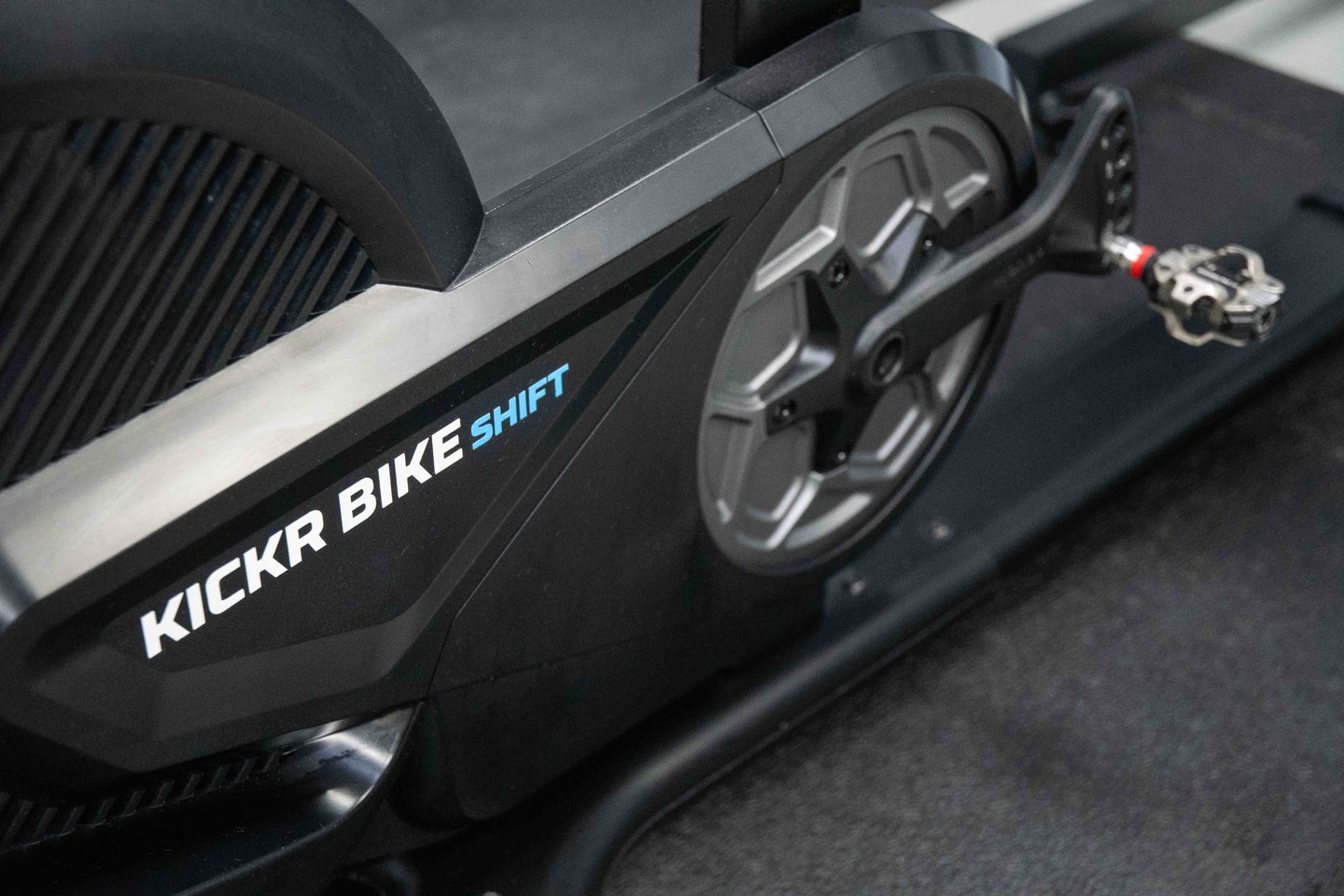
I didn’t exactly intend this review to end up as a long-term review, yet, here we are. After some 9 or so months, this is my complete Wahoo KICKR BIKE SHIFT In-Depth Review. The SHIFT is effectively a pared-down version of the existing Wahoo KICKR BIKE, yet, in some ways it’s actually better. For one, it’s actually silent. Two, it’s got less moving things to break. And three, it’s cheaper.
The KICKR BIKE SHIFT is aimed at being a (slightly) more affordable version than the full KICKR BIKE. The SHIFT is priced at $2,999, instead of the $3,999 for its bigger and older sibling. To get to that price point Wahoo removed a few pieces of hardware to reduce costs, but ironically, I came away largely favoring the cheaper variant.
I’ve been riding it on and off since last fall, before it first announced. You may remember that when I did my first hands-on post on it, I ran into some accuracy issues. Those initially got sorted relatively quickly after that post (via software update), but then I kept running into odd accuracy quirks on and off for another month or so. It’d be great for a week or two, and then boom, unexplainable accuracy issue. Well, some number of software updates later, and I haven’t had any of those issues for about 6-7 months now. Thus, I think it’s been long enough to call this thing ready for a final review.
With that, let’s dive into it.
How it Differs:
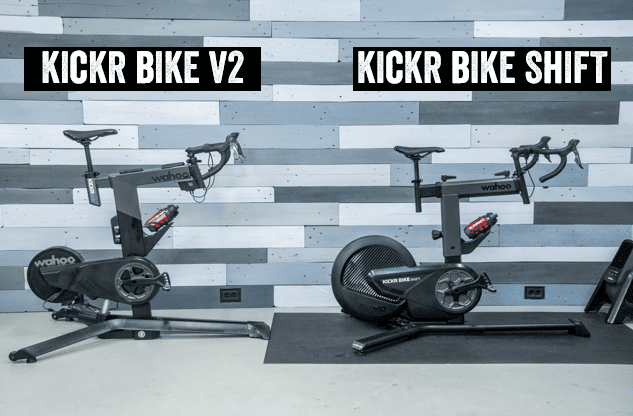
First though, I want to not-so-quickly recap how it differs from the higher-end KICKR BIKE V2 that came out in 2022. This part of the review is reprinted from my earlier first-look post, with some minor tweaks.
While the Wahoo KICKR BIKE SHIFT shares the name with the existing KICKR BIKE V1/V2, technologically, they’re almost entirely different. In fact, even structurally they’re almost entirely different. Everything from the frame design/size/materials is changed, to the entire flywheel/drivetrain system, to how the electronics in the shifters attach. About the only thing that’s the same is the saddle itself (even how it attaches is different), as well as the handlebars (and how those attach/connect is different).
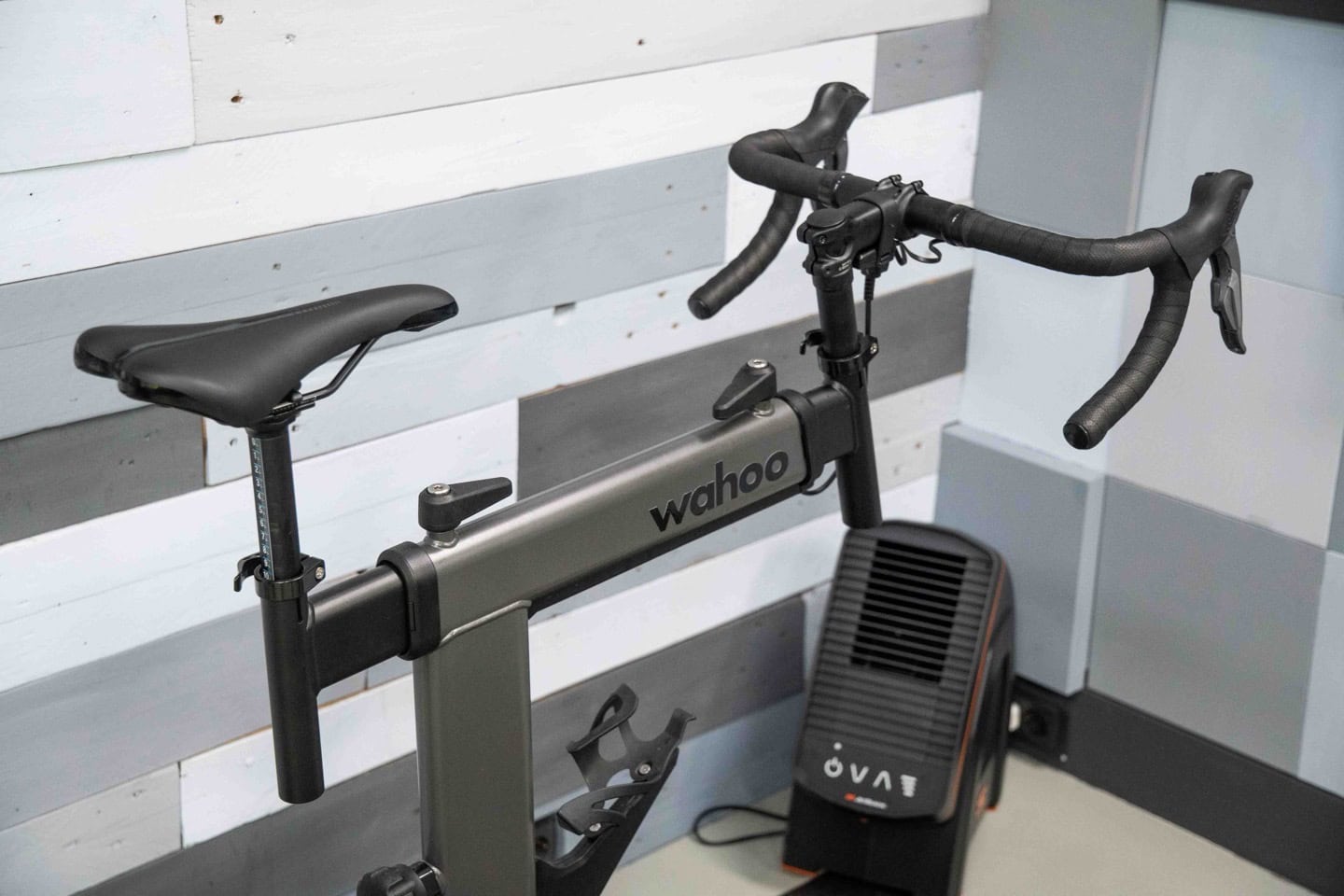
Let’s start out structurally first. You’ll immediately notice the KICKR BIKE SHIFT (aka KICKR Bike Jr) has much thinner components. While a chunk of this is weight savings (and those costs for shipping and material savings), another very real component is that it increases rider compatibility. A very common complaint about the existing KICKR BIKE V1/V2 is that the top-tube is really wide, and would often rub on thighs (mine included), depending on your exact fit. This new frame is much thinner, and I experienced no thigh-rub.
You’ll also notice new styled handles everywhere for this thinner design. On the whole, I don’t think the new handles are better or worse, just…different. Perfectly fine either way. As one who has a KICKR BIKE V1 at home, and has been riding the KICKR BIKE SHIFT at the office, I don’t have any real preference either way.
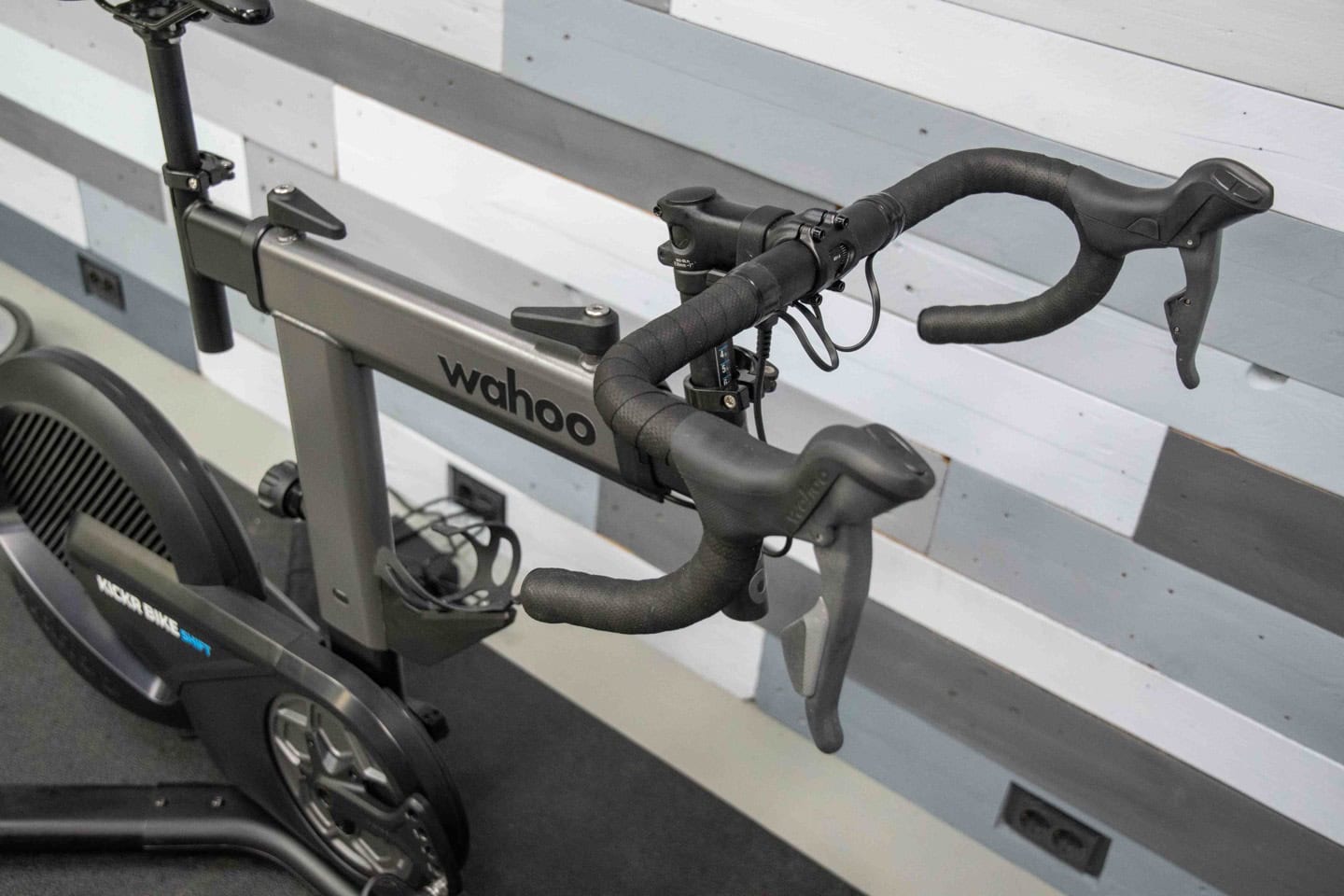
The next notable difference is the new seat post clamp, which has a hex-compatible nut in it, so you can actually crank it down with a hex wrench. Once I did that, then it was rock-solid staying put. I could have had a goat atop a cow style circus act up there, and it’d have stayed exactly in place. Whereas the KICKR BIKE V2 has a hand-friendly clamp, but is more prone to slippage.
Below at left: KICKR BIKE V2, and at right, KICKR BIKE SHIFT:
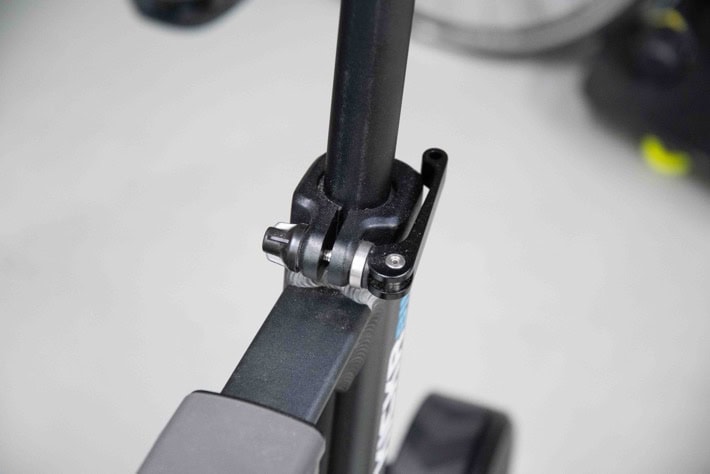
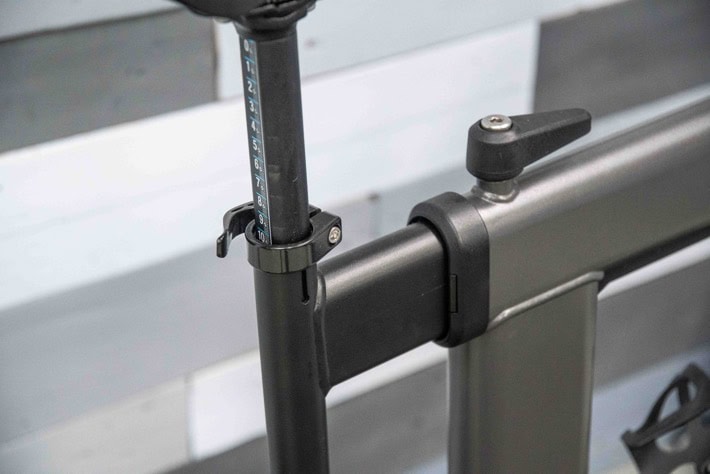
I asked whether or not the various markings on the KICKR BIKE V1/V2 were identical to the KICKR BIKE SHIFT markings (from a fit/sizing standpoint), and said while they are very similar, things are slightly different by a few millimeters. However, if you use the Wahoo app to input your fit coordinates (such as from a bike fitting system), it’ll spit out the correct markings for whichever version of the bike you’re using.
Meanwhile, transitioning towards some of the electronics pieces, towards the front you’ll notice a lack of messy wiring. Gone are all the silly cables running everywhere, replaced instead by a kinda-sorta-Di2/AXS junction box style situation. This is where the shifter cables come into, but also where the power runs through, as well as status lights for wireless communications. This is actually magnetically attached:
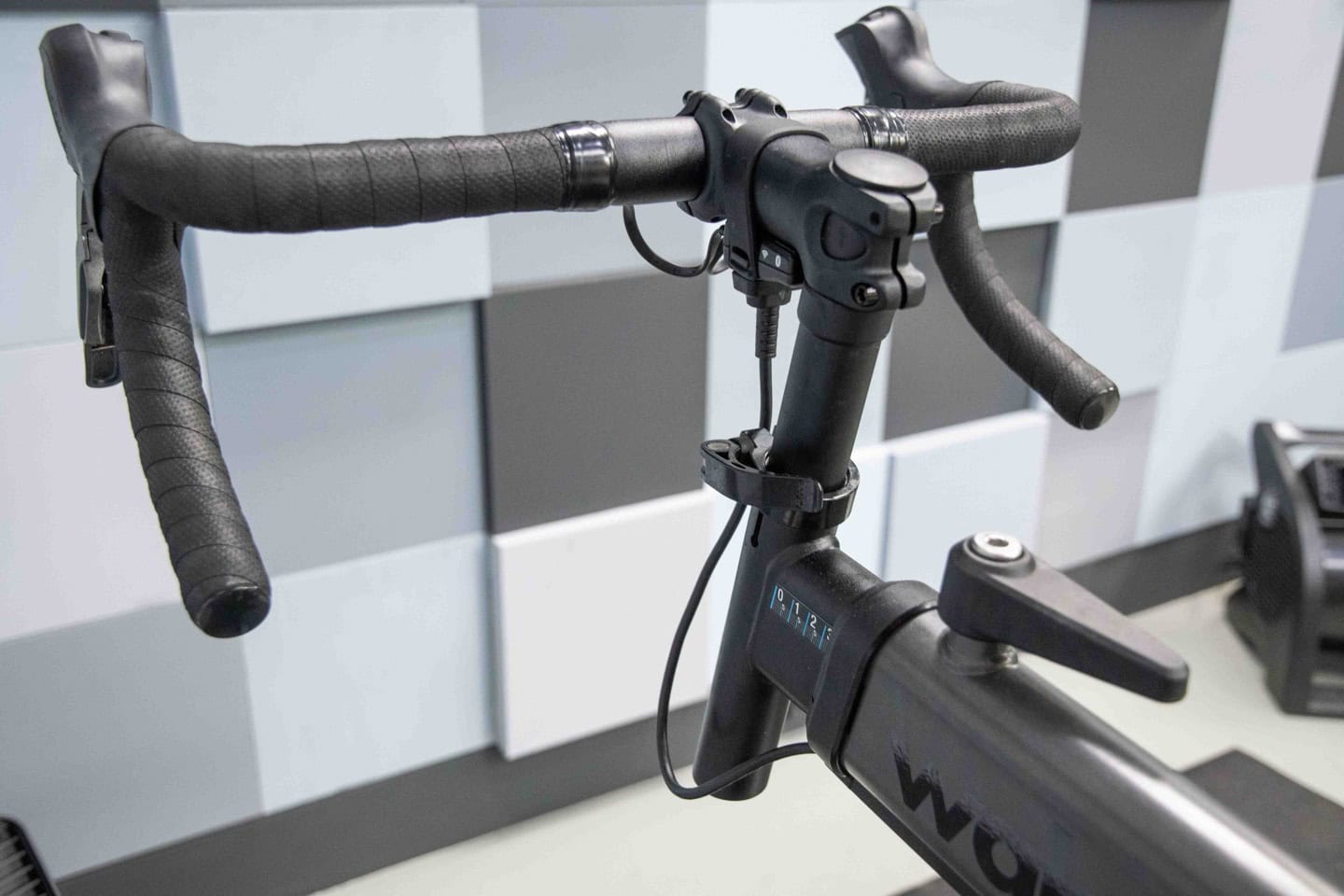
While there was some initial concern about the magnets not being strong enough and potentially disconnecting mid-ride (thus, disconnecting your power broadcast/etc), I’ve never once had that happen on a ride. Not from bumping, nor towel, or anything else. Thus, this has seemingly stood the test of time.
Meanwhile, on the backside of the KICKR BIKE SHIFT we’ve got the entirely new drivetrain/flywheel system. This is not the same motor-driven electromagnetic drivetrain that you have on the KICKR BIKE V1/V2, thus it can’t simulate downhill/forward speeds (e.g., coasting down a hill). It’s more in line with the Wahoo KICKR trainers in terms of how it works. Visually (externally), I kinda like it actually. In any shots where you see ‘white’ or reflecting looks to it, that’s just a crapton of studio lights reflecting off-angle. In person, it’s just black. Albeit, very shiny black.
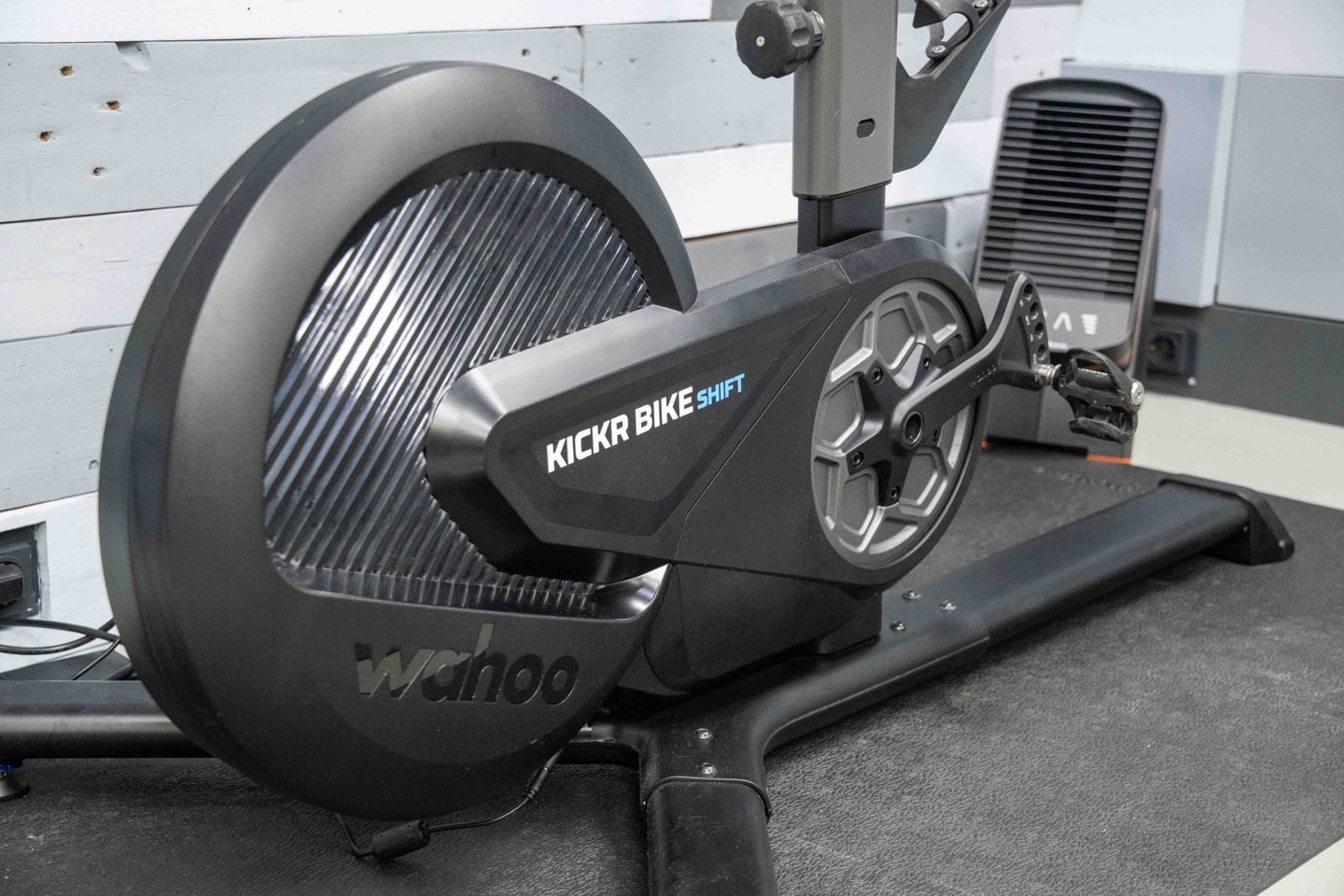
This new drivetrain system is dead-silent. It makes zero sound whatsoever. Not pedaling, not coasting, nothing. Every time I get on the KICKR BIKE V1 (or the other V2 I have floating around), it’s a stark (loud) reminder of the difference.
In fact, that’s not the only quiet thing here – also, the lack of built-in KICKR CLIMB gradient simulation means that it’s mechanically much simpler. No crazy up/down systems, or pivot points. It’s…well…simple. And as such, everything about it is quiet. That’s notable when compared to the KICKR BIKE V1 and V2, which have a long history of slowly getting louder over their individual lifespans. My KICKR BIKE V1 seems to groan and make noises even when I look at it And when I get on and start pedaling? It’s debatably akin to an adult film production set happening down below. Whereas the KICKR BIKE SHIFT is just so effin quiet. It’s insane how quiet by comparison – roughly like a Peloton Bike.
However, the one thing that I did immediately notice is the lack of a physical gearing display. On the KICKR BIKE SHIFT there is no gear indicator/display like there is on the KICKR BIKE V1/V2. That’s particularly challenging in Zwift, since Zwift doesn’t display which gear you’re in for the KICKR BIKE (it does for the Tacx NEO BIke, Wattbike, and probably some others) – but not Wahoo.
During my first-look at this bike nearly a year ago (Sept 2023), Zwift and Wahoo said this was coming for the KICKR BIKE SHIFT. Meanwhile, here we are in June 2024, and it’s still not there. I poked Zwift and Wahoo again, asking who exactly was to blame.
In short, Zwift & Wahoo collectively agreed Zwift was to blame here. It sounds like things are closer than ever, as there’s some updated protocol pieces going into place within Zwift for trainer companies to use in the very near future (a number are already internally testing it). It’s this updated integration point that will allow Zwift to display the KICKR BIKE SHIFT gears. That said, when other companies like Indievelo can do it over a lazy weekend, we shouldn’t have to wait a year for this very basic thing to happen.
Finally, here’s some tech spec stuffs, because, everyone likes tech specs:
– Power Accuracy claim of +/- 1%
– Max 20% simulated incline (of resistance unit)
– Max 2,200w supported resistance
– Zero-calibration software algorithm
– Dual ANT+/Bluetooth Smart support, including ANT+ FE-C, plus power/speed/cadence broadcasting
– Built-in always-on WiFi (2.4 GHz)
– Retains existing KICKR Direct Connect wired port option for connectivity (requires adapter)
– Bike weight: 100lbs/40kgs, max rider weight 250lbs/113.4kgs
– Requires power cable/be plugged in
– Does *NOT* have KICKR Race mode like KICKR BIKE V2 does
In any event, let’s dive into the box.
In the Box & Setup:
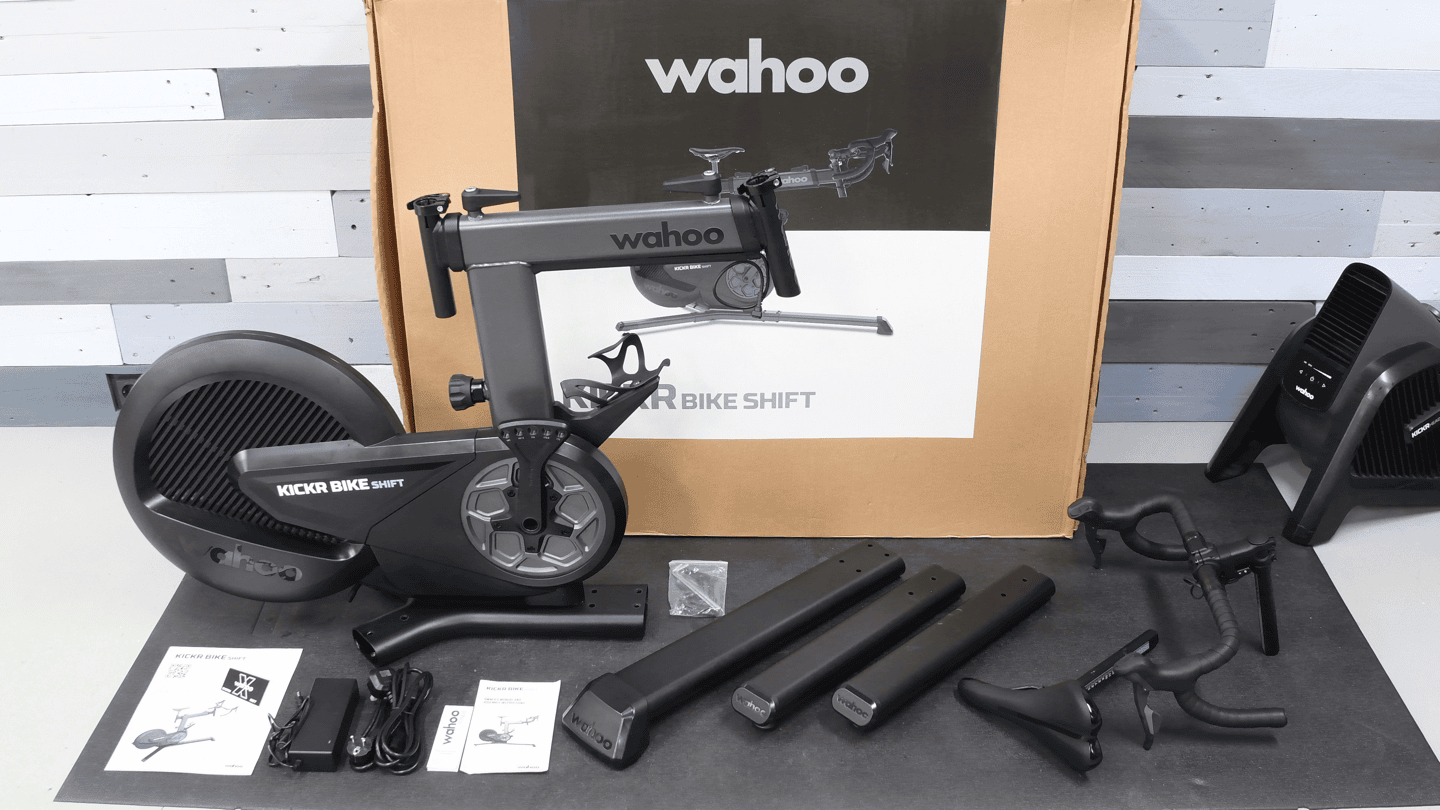
The KICKR BIKE SHIFT setup is thankfully neither complex, or time consuming. You’ve essentially got the main frame, legs, seat post, and handlebars to slap together. Plus, a decision on pedals.
You’ll first start by attaching the three legs via the few bolts for each leg, giving stability to your rocking horse:

Then, you’ll choose to install the seat post or handlebars next. Obviously, the manual would give you guidance on the proper order, but that’d take the fun out of things. Either scenario is simply sticking it in the hold and tightening the little lever.
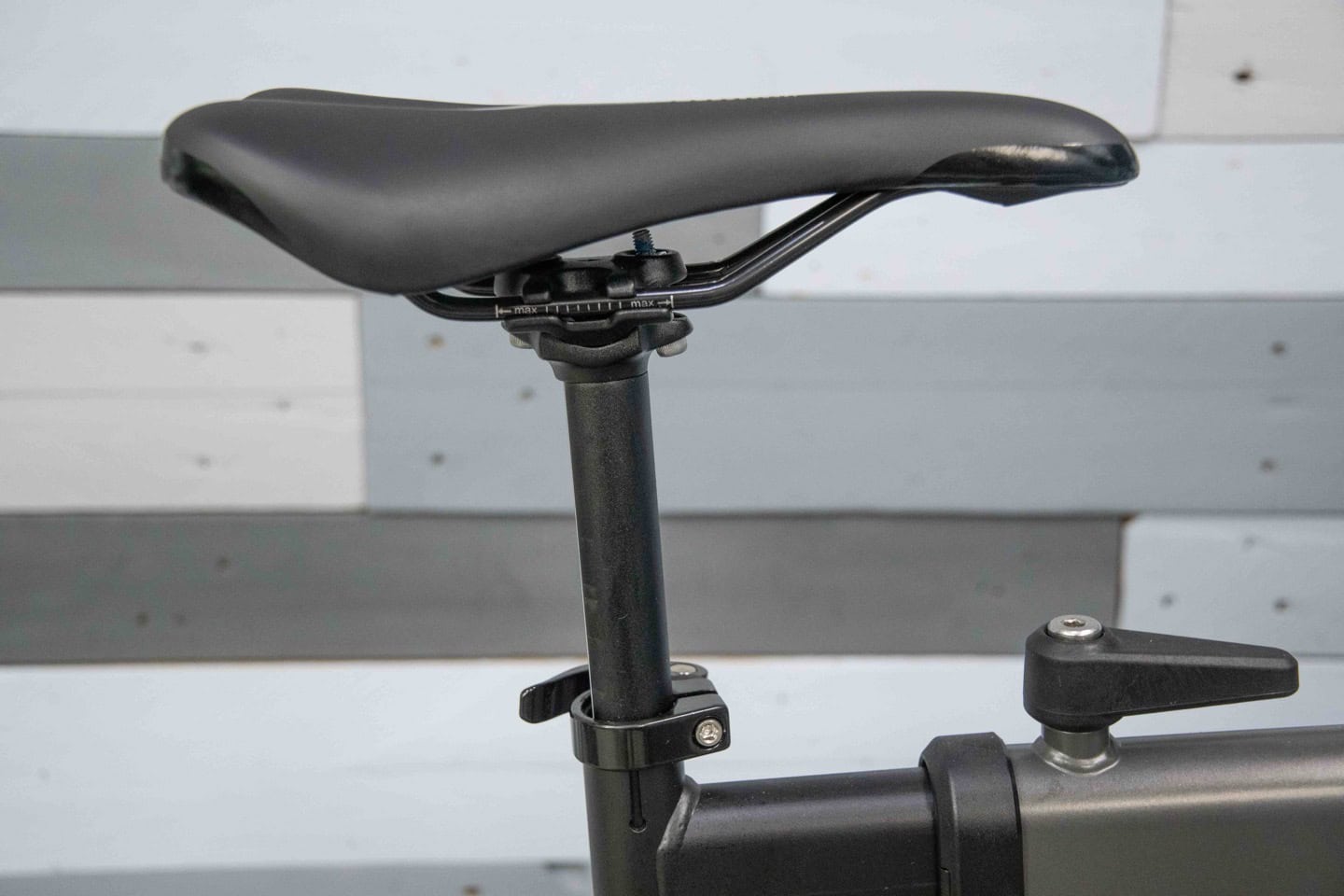
From there, do the other part you didn’t do in the previous step. Insert into hole, tighten lever. Both the seat post and handlebar are designed to adjust of course, for different rider sizes (more on that later).
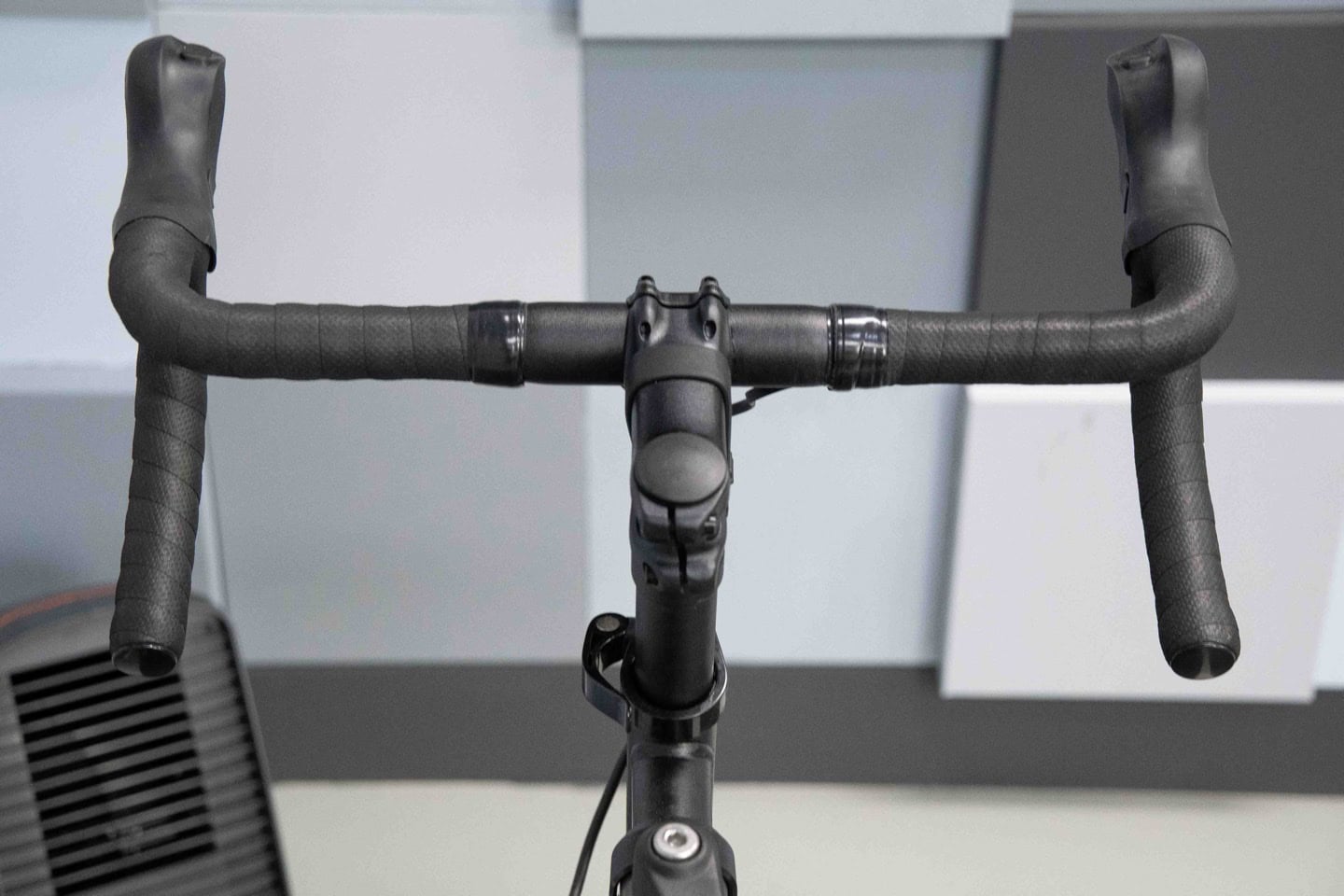
In the case of the handlebar, you’ll want to attach the small magnetic cable to it, which is what powers the connectivity on the handlebars and bike. That power runs from the cable at the back of the bike, past the electronic resistance unit, and ultimately up to the handlebars via this little magnet mount system.
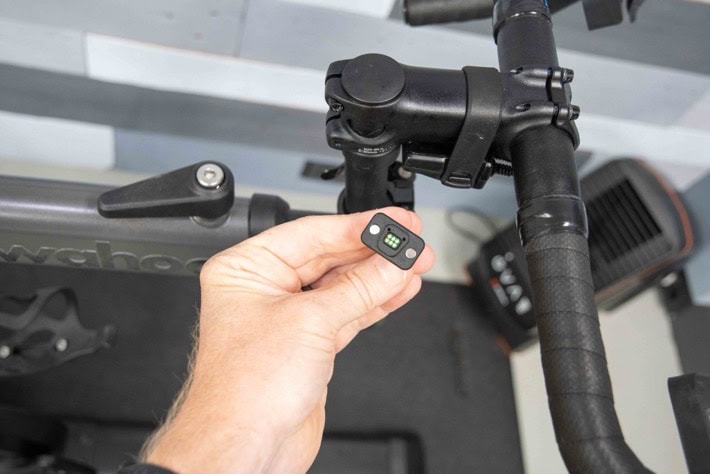
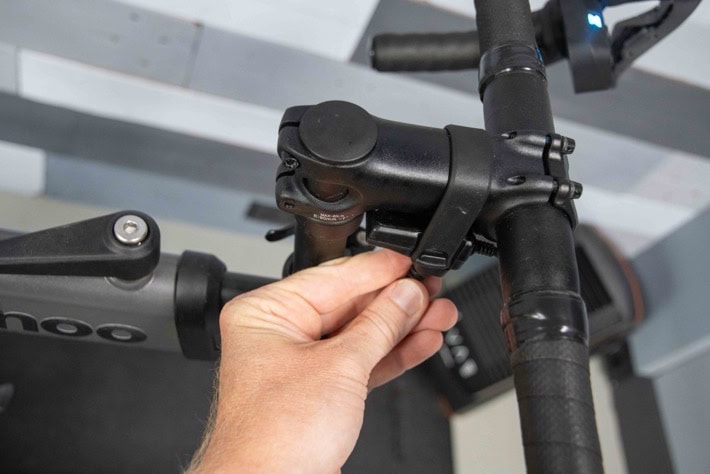
Next, you’ll go ahead and connect up the power supply at the back of the bike. One end into the bike (just below the ‘wheel’-looking thing), and the other end to an outlet of your choosing.
Lastly, stick on some pedals in the appropriate crank length holes. But more on which holes to put them in, in the next section!
With that, we’re ready to start pedaling.
Bike & Rider Fit Options:
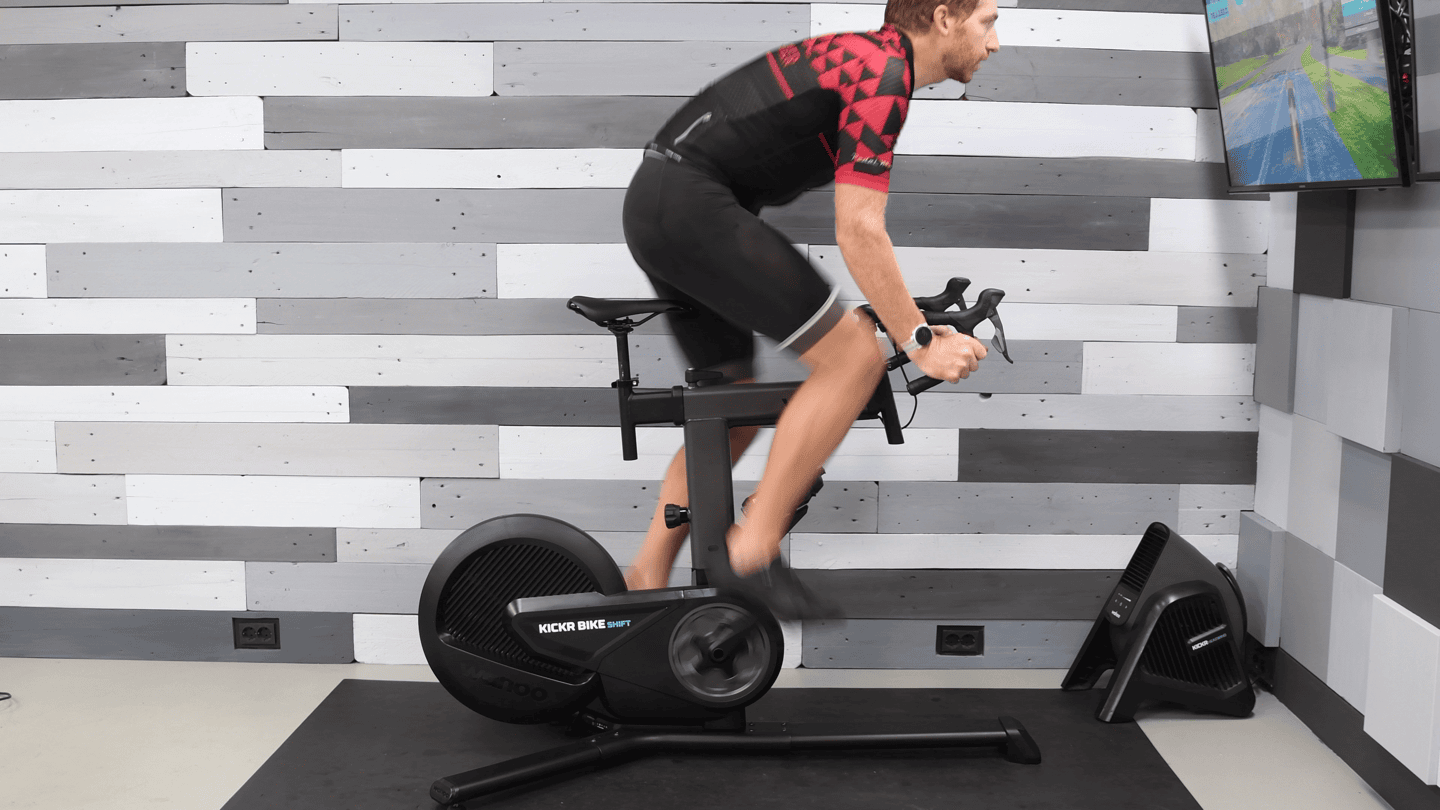
Of course, one of the major reasons people buy indoor smart bikes is to share them within the household with other family members. Thus, adjustability to different rider sizes is pretty important. But in terms of the range of fit options, but also how quickly you can change those bike to adapt to someone else riding it. If the process takes forever, you’re less likely to ride the bike.
In this case, Wahoo changed the handles a bit from the more expensive KICKR Bike to make them a bit less sleek – aligning instead towards more traditional indoor bike adjustment levers. Again, this doesn’t bother me at all.
There are six core ways you can adjust the bike:
1) Saddle height (up/down)
2) Saddle position (forward/back/angle of saddle)
3) Handlebar height (up/down)
4) Handlebar position (forward/back)
5) Stand-over height adjustment (up/down)
6) Crank length
In addition, the seat height is actually two metrics blended together: Stand over height + Saddle height.
Each of these areas has a small ruler on one side, making it easy to write down or memorize the exact measurement for each rider in the family.
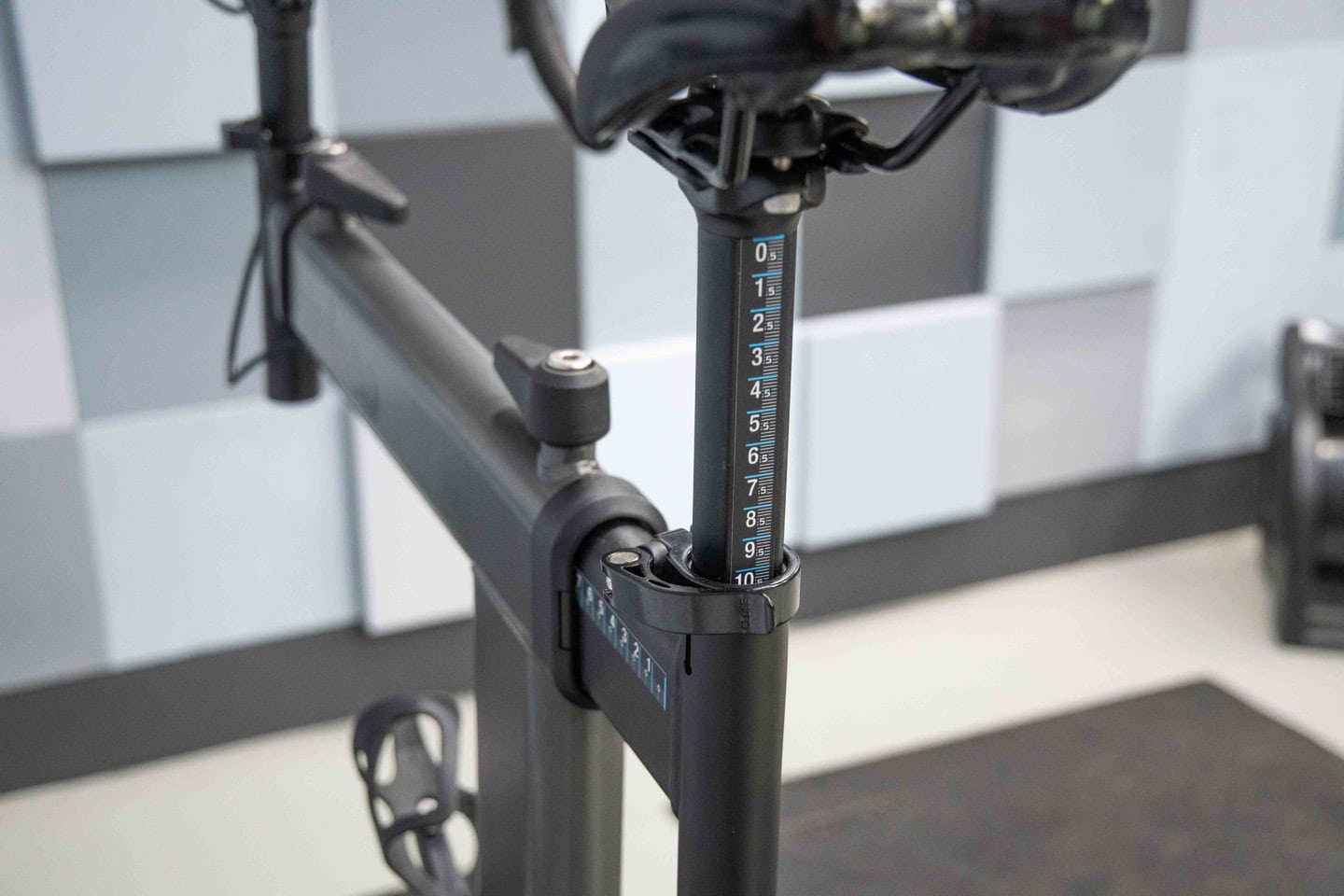
The clamps pop-up to rotate freely, such that they can always be placed ‘out of the way’, and not blocking your legs.
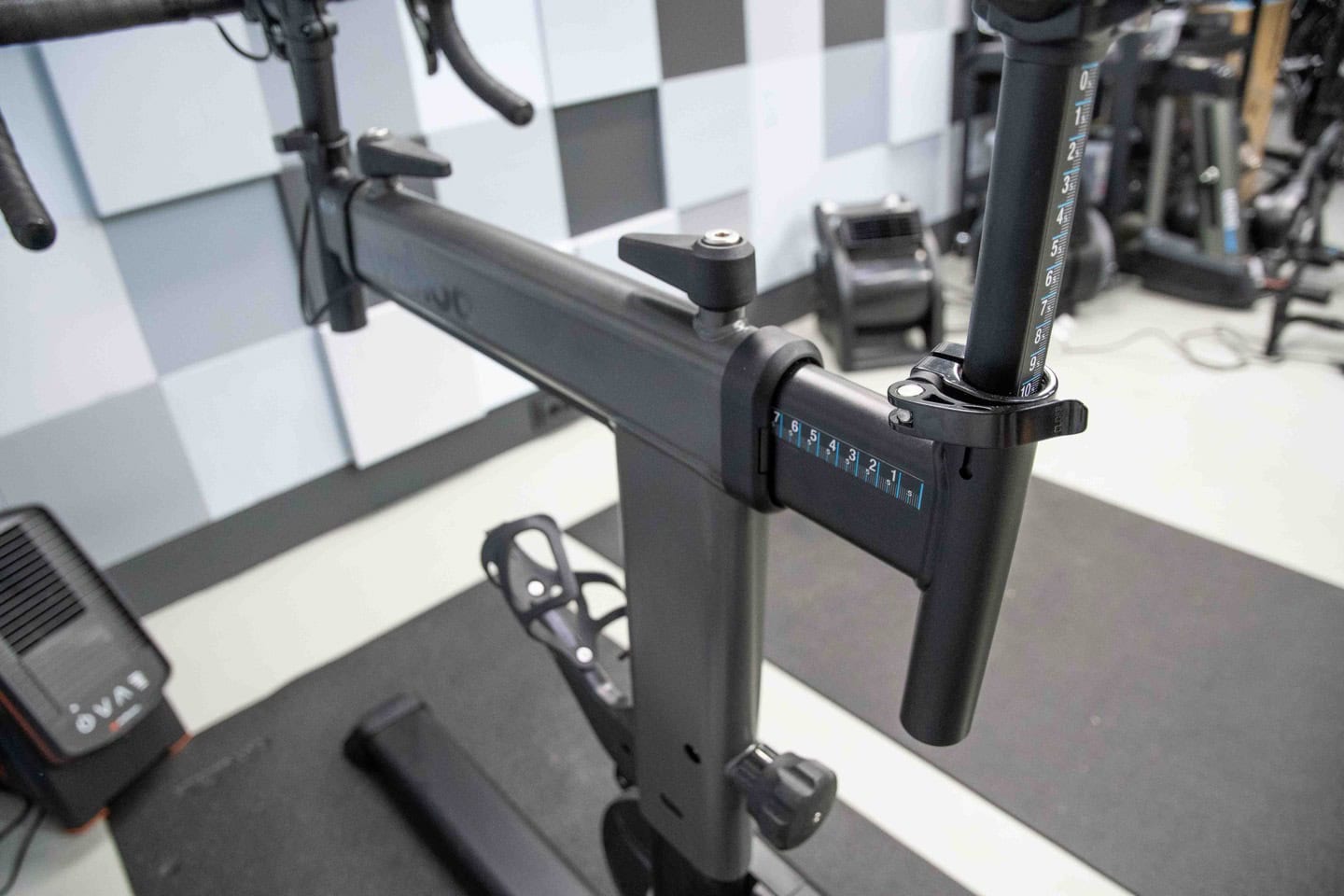
One change that Wahoo has made on the SHIFT compared to the more expensive KICKR BIKE’s, is the seat post clamp design. This new design allows usage of a tool to tighten it up, and is supposed to improve slippage issues. And to a certain degree, it does.
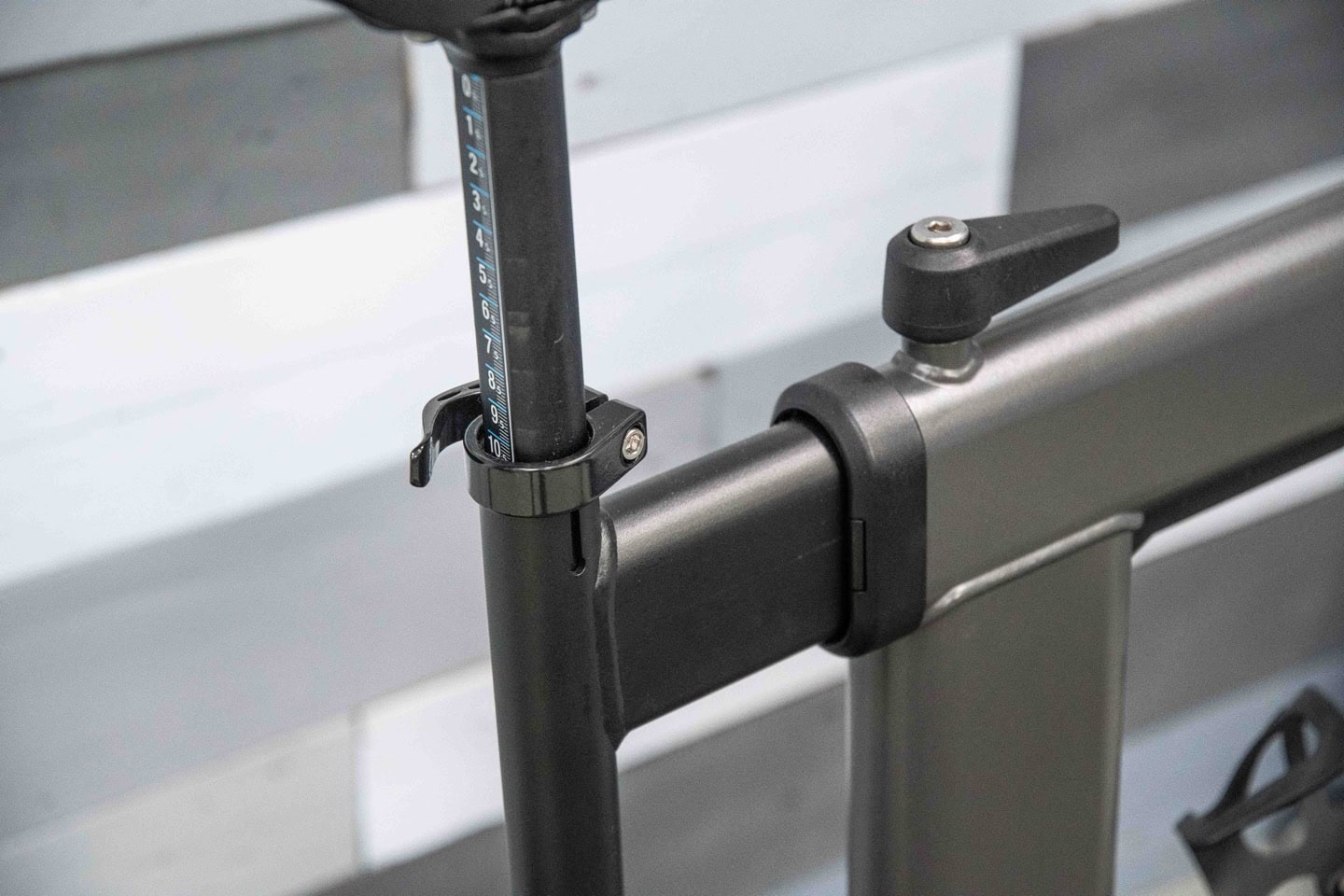
However, the elephant in the room continues to simply be Wahoo’s usage of a non-round seat post. Presumably this is done for style/visual reasons, but it still introduces unnecessary slippage unless you really crank it down. Note that you can simply put your own standard seat post/saddle in there. In fact, that’s what I do at home with my older KICKR BIKE V1, where my wife and I each have different saddles on cheap $9 seat posts. Problem, easily solved.
When it comes to figuring out the right fit, Wahoo has a little calculator/guided system within the Wahoo app. This includes two options:
A) Enter in your height and inseam, as well as preferred position (relaxed/endurance/race) and it’ll give you the KICKR BIKE SHIFT measurements
B) Utilize a well-known bike fit measurement system from GURU Fit System, Retul Fit, and Trek Precision Fit, which will give you the right measurements for the SHIFT.
You can see here some of these screens. It’s all pretty straight forward, but as always, you may want to tweak it slightly based on how it feels after a ride or two:
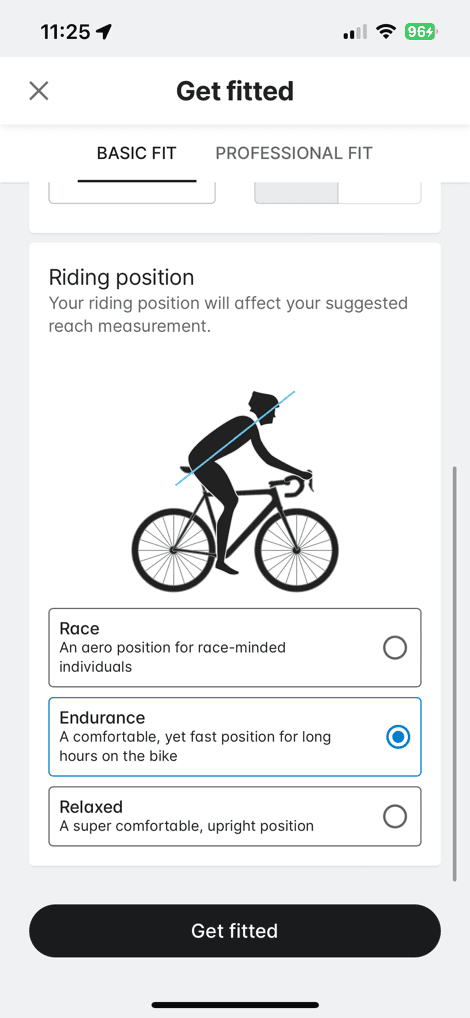
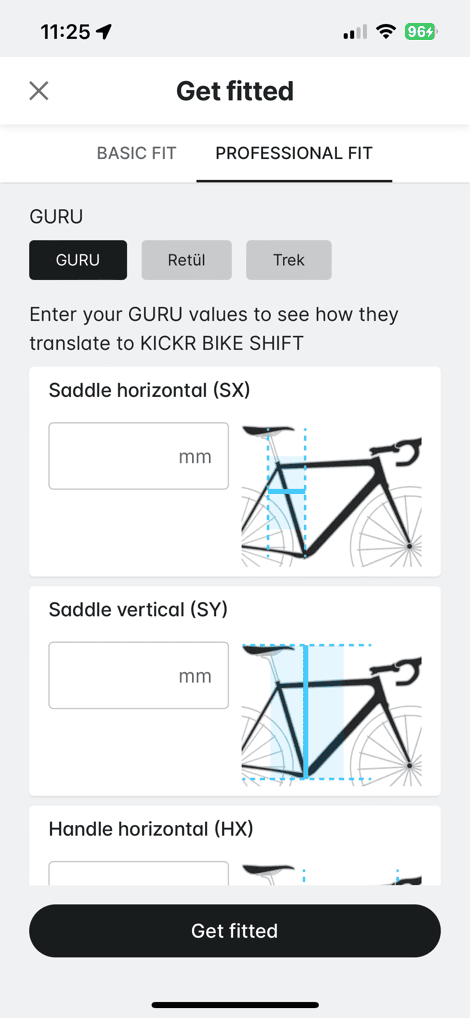
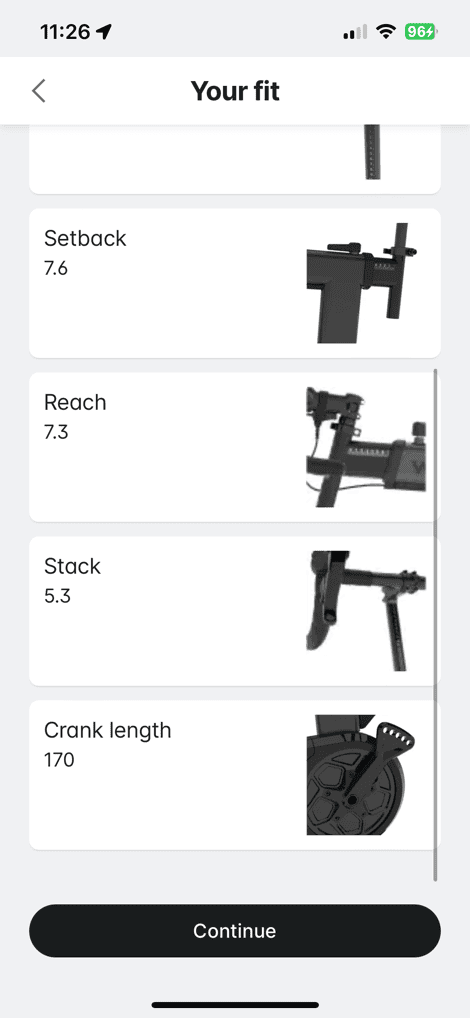
You’ll notice that the measurement it gives are both the numerals on the rulers next to each component of the bike, as well as the A/B/C/D/etc next to the standover height adjustment. Notably, the new Wahoo app seems to have done away with the ability to take a photo of your bike with your phone, and have it estimate the fit coordinates from the imagery.
One of my somewhat favorite fit aspects of the KICKR BIKE SHIFT is that the top-tub is much slimmer than past KICKR BIKE’s. For many people, the width of the top-tube caused constant rubbing on your thighs, and was by far the largest (in width) top-tube of any indoor bike on the market near where your legs would rub (the Tacx Bike doesn’t have a top tube that goes across to rub again).
Next of note is crank length adjustment. Wahoo uses a bear-claw style system, which means you simply put your pedals in whichever crank length hole you want. They support 165/167.5/170/172.5/175mm crank lengths, and the app (as seen above), will also help you choose which crank arm length to use, if you aren’t familiar:
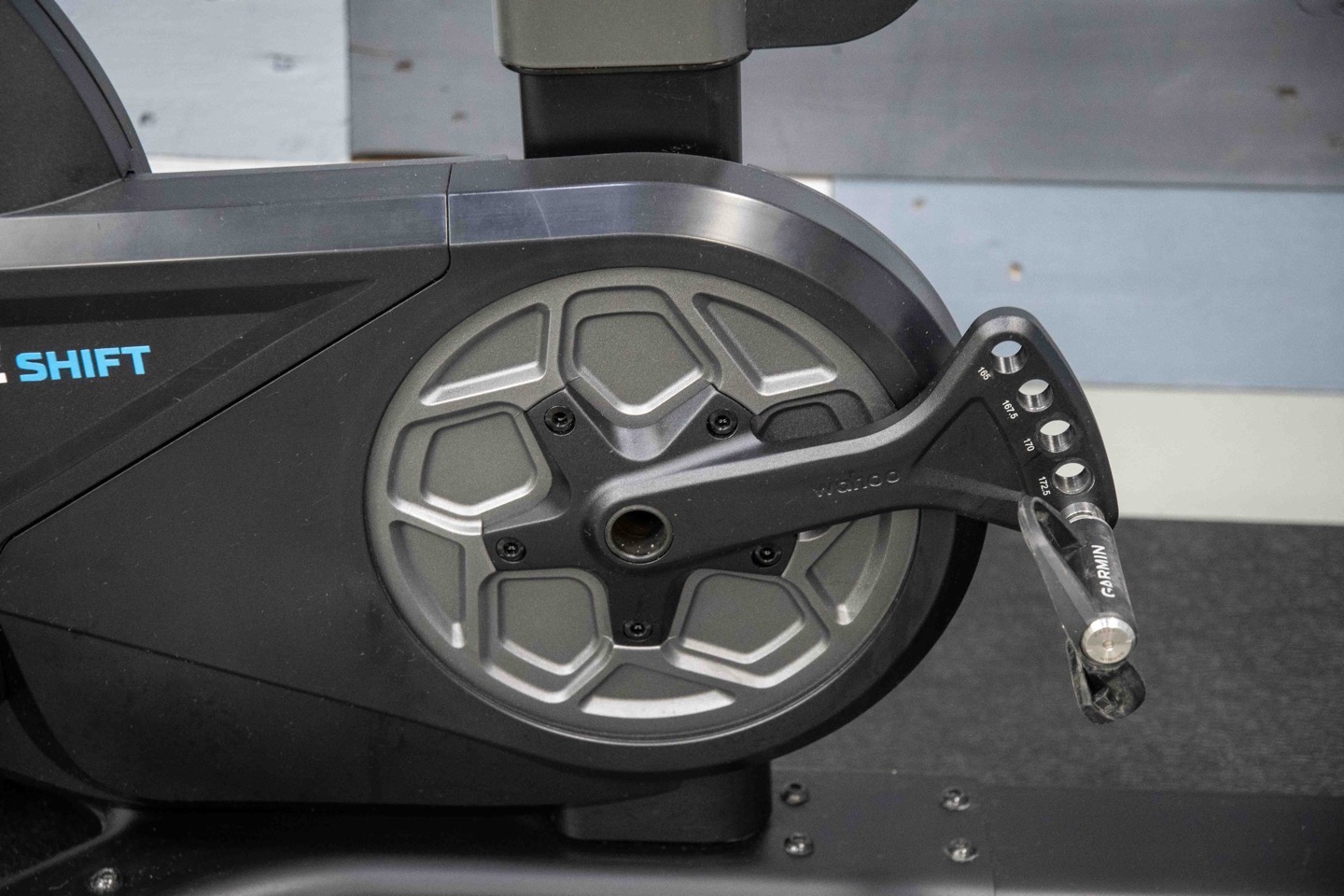
Notably on the KICKR Bike SHIFT, they simplified this design compared to their previous iterations which had more stylistic flare but probably weaker points, likely as a result of some breakage that was seen by a few people.
Lastly, as for triathletes, note that the KICKR BIKE SHIFT uses standard handlebars, thus, you can easily install clamp-on aero bars on this setup. I didn’t do it for the KICKR BIKE SHIFT, but do have them on my KICKR BIKE V1 at home, which looks like such when I first photographed it years ago:
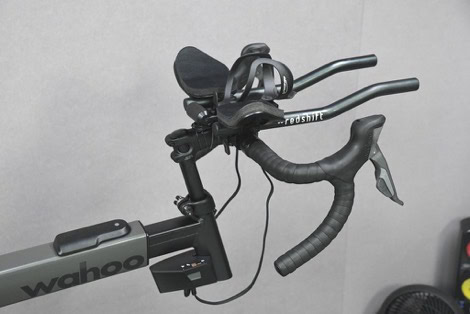
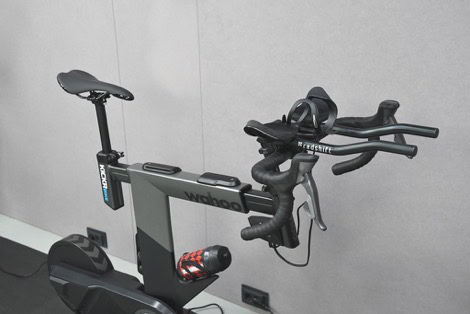
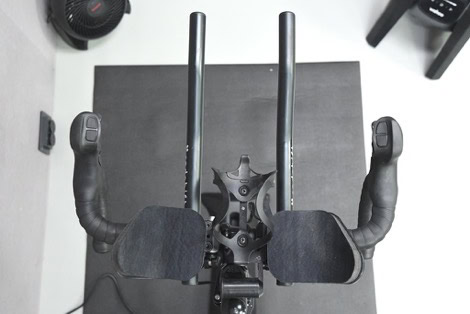
The only downside being there’s no remote shifters on the KICKR Bike (either unit), so any shifting will still need to be done at the handlebar shifters.
Riding It:

Let’s dive into riding it day to day. In this section I’m going to talk about more subjective things – such as road-like feel and movement. As well as some logistical basics, though for deeper technical aspects like protocols, see the App Compatibility section after this.
When it comes to pairing up to your favorite apps, the KICKR BIKE SHIFT does support all of them easily. Starting with the most popular, Zwift, you’ll pair it up first as a power source and resistance trainer, then cadence, then the ‘Steering’/Controls option, which allows you to steer within the game.
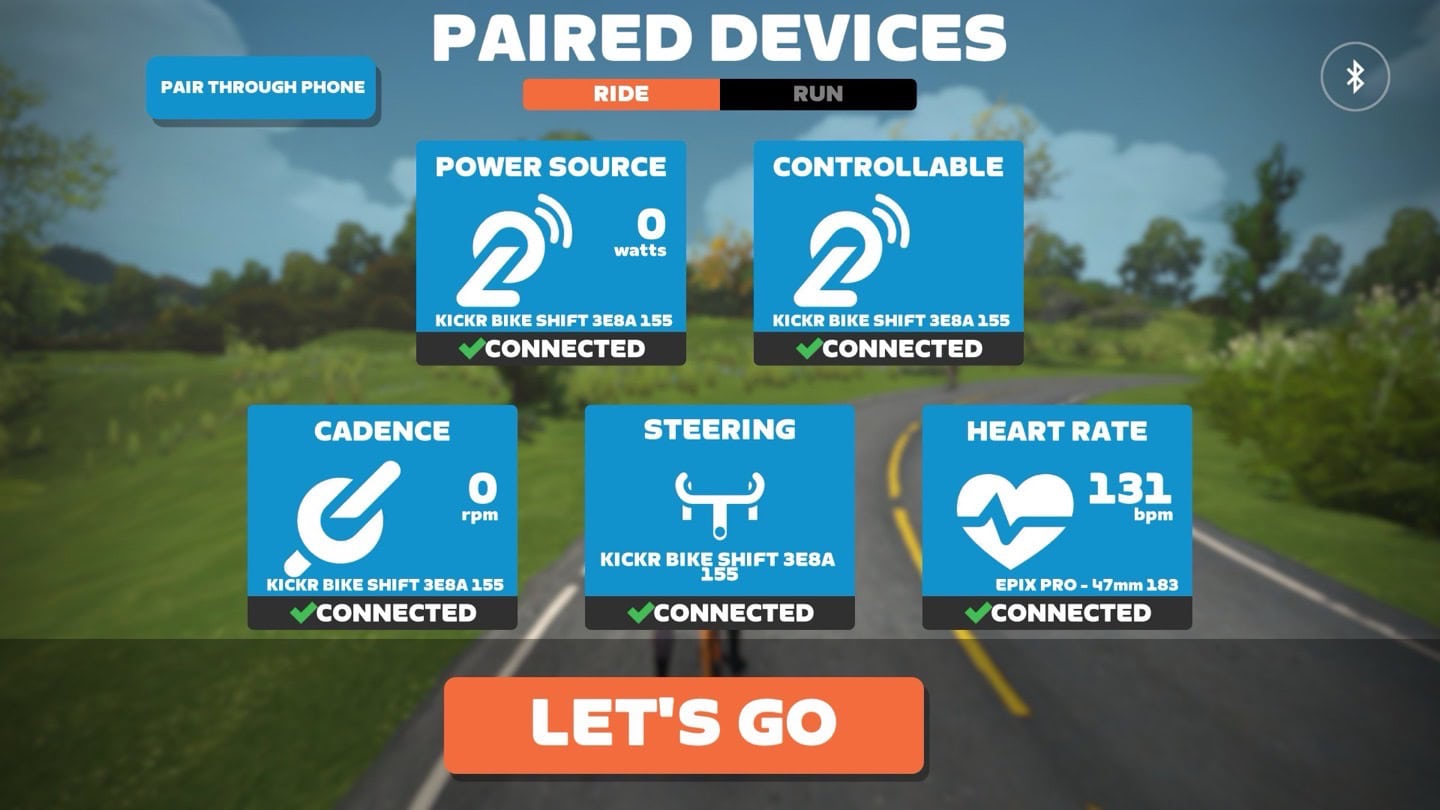
However, one thing you may want to briefly do is swing back to the Wahoo Fitness app, to setup your specific shifting preferences. The KICKR BIKE SHIFT allows you to customize the shifters to three different shifting types:
A) Sequential
B) Shimano (akin to Di2)
C) SRAM (akin to AXS/eTAP)
Within that, you can then create specific bike gearing profiles, choosing from common chainring/cassette combos, or creating your own (also, I have no idea why my “Life Odometer” reads 0km, instead of however many kilometers I’ve actually ridden):
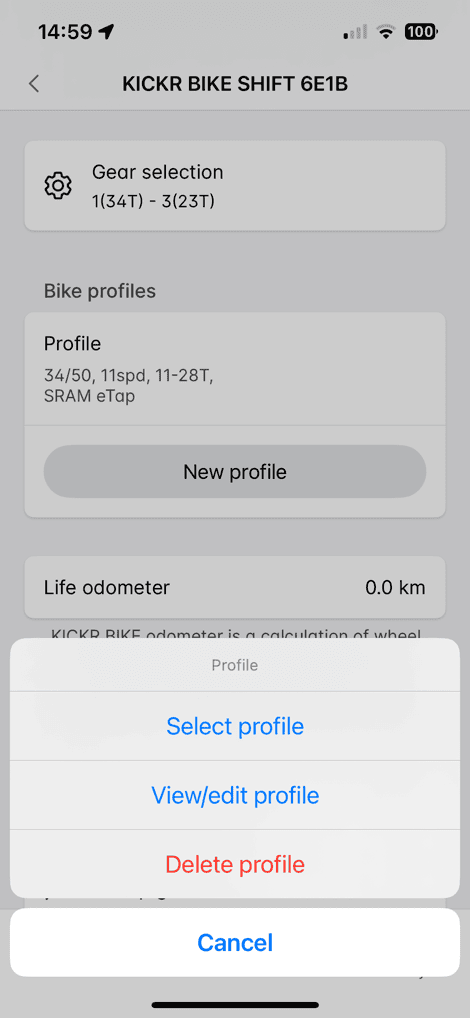
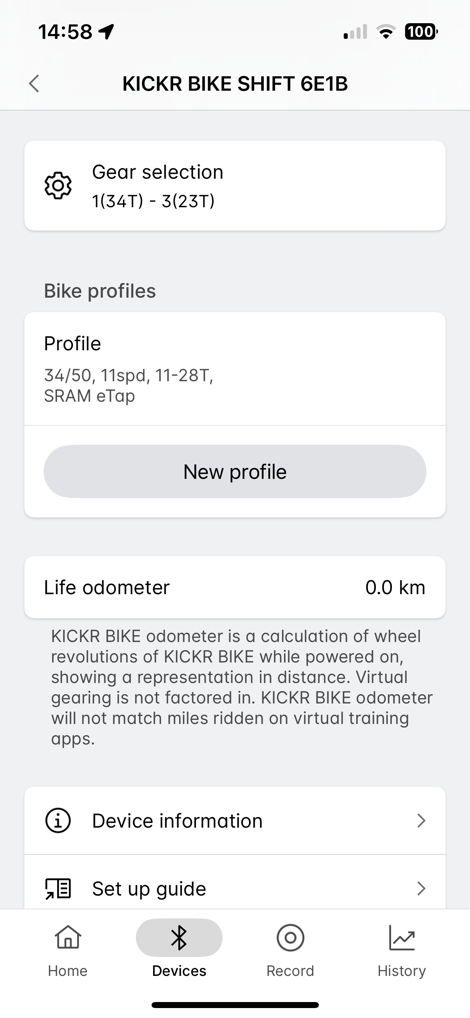
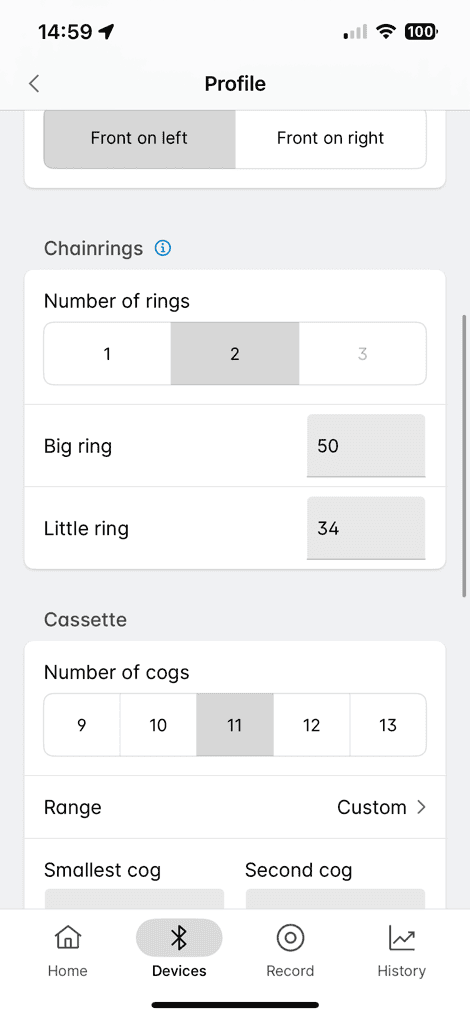
You can create multiple bike/rider profiles. Though, as has been the case since the beginning of KICKR Bikes, you’ll need to remember to switch these before you start riding in Zwift/etc. In an ideal world, Zwift and other apps would have this be a quick-select option in the game (or even tied to virtual bikes), getting rid of per-rider switching that must be done on the Wahoo app. In some ways, IndieVelo gets reasonably close to that, as I can tweak the shifting the gearing a bit there:
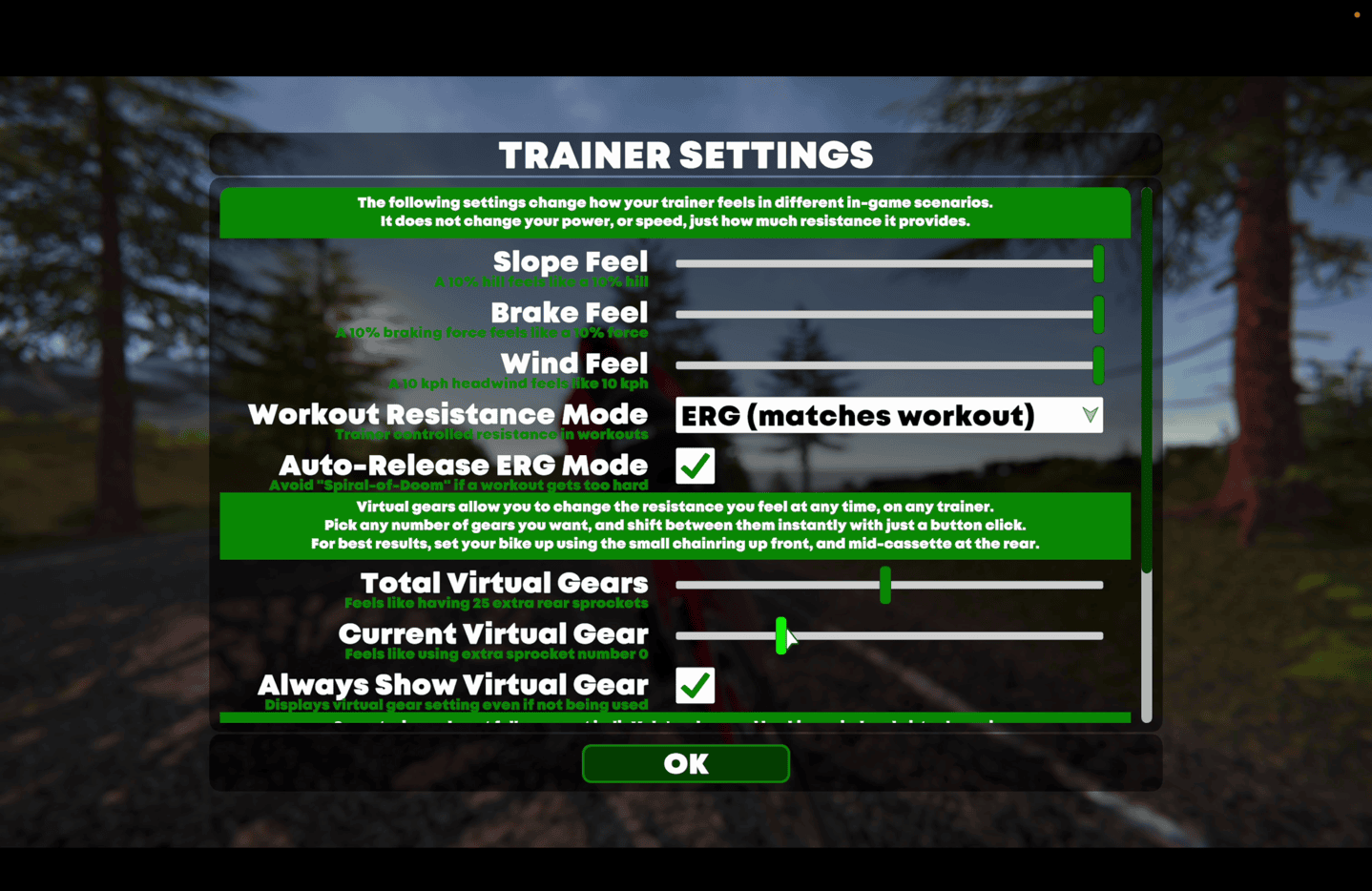
In any event, with that settled, you’ll go off and start pedaling in the game of your choice. Below is Zwift in simulation mode (called SIM mode), which is the mode used when it ‘simulates’ the gradient of a route (e.g. going up a 5% hill). In this case it’ll automatically make the trainer feel like a 5% hill, albeit, that does depend on the ‘Trainer Difficulty’ setting you have in the app. By default Zwift is actually only 50% difficulty level, so it’ll feel more like a 2.5% hill instead of 5% if you don’t change it.
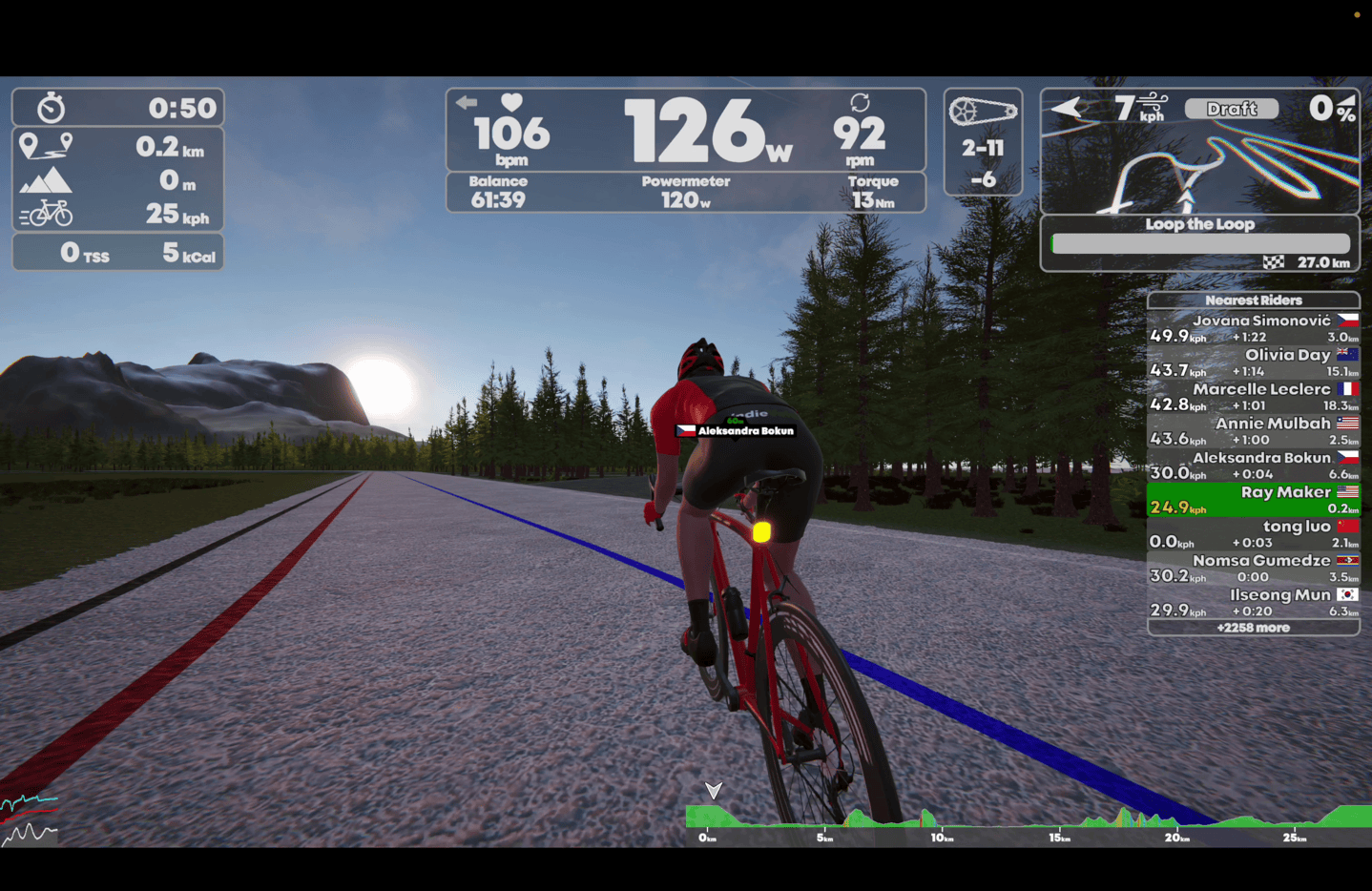
Unlike the KICKR BIKE V1 & V2, the SHIFT doesn’t physically move/tilt the bike up and down. Which, is totally fine. Having the bike go up/down as you go up/down hills is fun, but isn’t something I’ve actually used much on the KICKR BIKE V1 that I own. This is largely because I almost always forget to unlock the feature before each ride, and just totally forget about it. In talking with many KICKR Bike owners over the years, many fall into this same camp. Of course, some absolutely love it – to each their own!
Next there’s the ‘road-like’ feel aspects. How does acceleration and deceleration feel? When you sprint, does it ‘feel’ real? In this case, yes, it feels good and real. That’s notable because it’s actually a very different technology than the KICKR BIKE V1 & V2. The KICKR Bike SHIFT is more akin to the Wahoo KICKR smart trainers, whereas the KICKR BIKE V1/V2 use an electromagnetic system (like a Tacx NEO series device). In most riding scenarios you won’t notice the difference. However, one area they are different is descending. In the KICKR Bike V1/V2, it’ll actually propel/motor the ‘wheel’ (flywheel) forward, so it’ll feel like you’re going downhill. Whereas in the SHIFT, if you stop pedaling, eventually the bike’s flywheel will stop, as if you were on flat ground.
Again, like the KICKR CLIMB up/down part, if you’ve never had that experience before, you won’t notice missing. Whereas, if you have had it, you may or may not notice lack of it. Totally depends on personal preference.
Of course, all of that described ‘SIM’ mode, whereas in ERG mode you’ve got structured workouts. In that case, the SHIFT is simply controlling the wattage per your structured workout. Here’s an example from Indievelo where it’s controlling the SHIFT. As always, there’ll be a slight variance second to second between what it sets, and how you pedal. But it’ll otherwise hold things well:
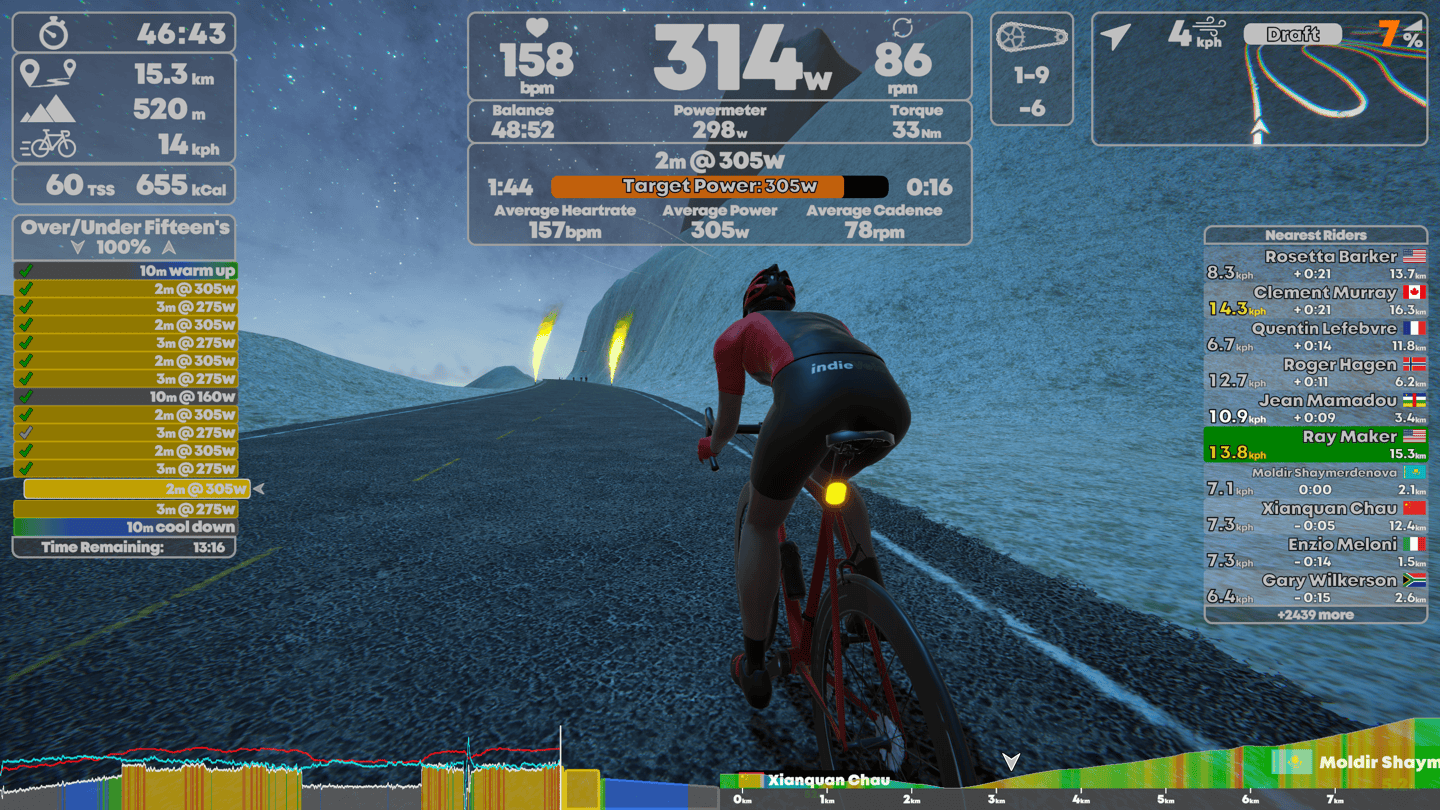
Speaking of things that spin – what about noise? It’s quiet. Which, is unlike the KICKR BIKE V1/V2, which will make all assortment of noises (especially as it ages). The V2 is definitely quieter than the V1, especially in the aging department. But both V1/V2 are louder than SHIFT. Shift is essentially silent. Here’s a quick noise test I did previously:
Now, circling back to shifting and breaking, I really like the KICKR BIKE/SHIFT handlebars/shifters. Specifically, I like the fact that they feel like real shifters, not just some gamified buttons. I think that’s super important in a smart bike. After all, if I wanted simple buttons I’d play a video game on the couch. Instead, I want to feel like I’m riding a bike. And the KICKR BIKE SHIFT nails that:
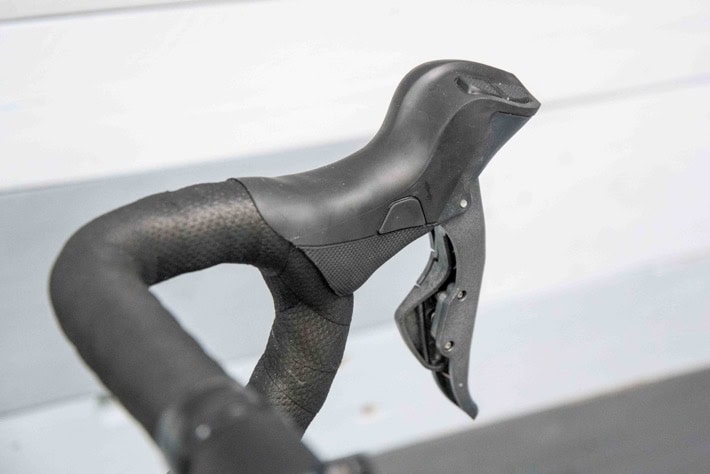
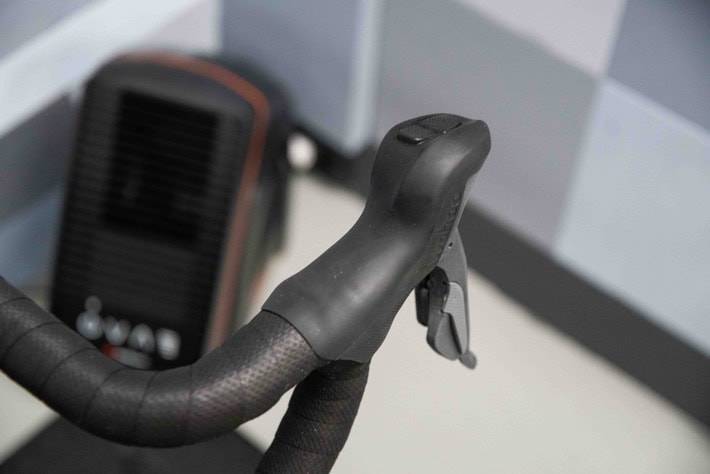
You feel the ‘click’ of a shift, just like on real handlebars/bikes. And as noted earlier, you can recreate both Shimano and SRAM style shifting. Likewise, you can also brake using the brakes on the front, which slows your avatar in most games. Honestly, I have no reason to make my person go any slower, I’m already slow enough as it is.
To steer within games that support steering, you’ll use the two ‘inner’ buttons, seen on the inside of each shifter. This will move you across the designated lanes within that game, depending on how the given game is coded to support steering commands.
Lastly, what about movement and feel? Certainly, this bike lacks any sort of rocker-plate type functionality. So you’re not going to get as much movement as you would on something like the KICKR MOVE smart trainer, or sticking the whole thing on a rocker plate. But given the frame design you do get a bit of sway out of it. I’d classify it as ‘perfectly fine’. Nothing amazing movement-wise to write home about, but nothing that bugs me either.
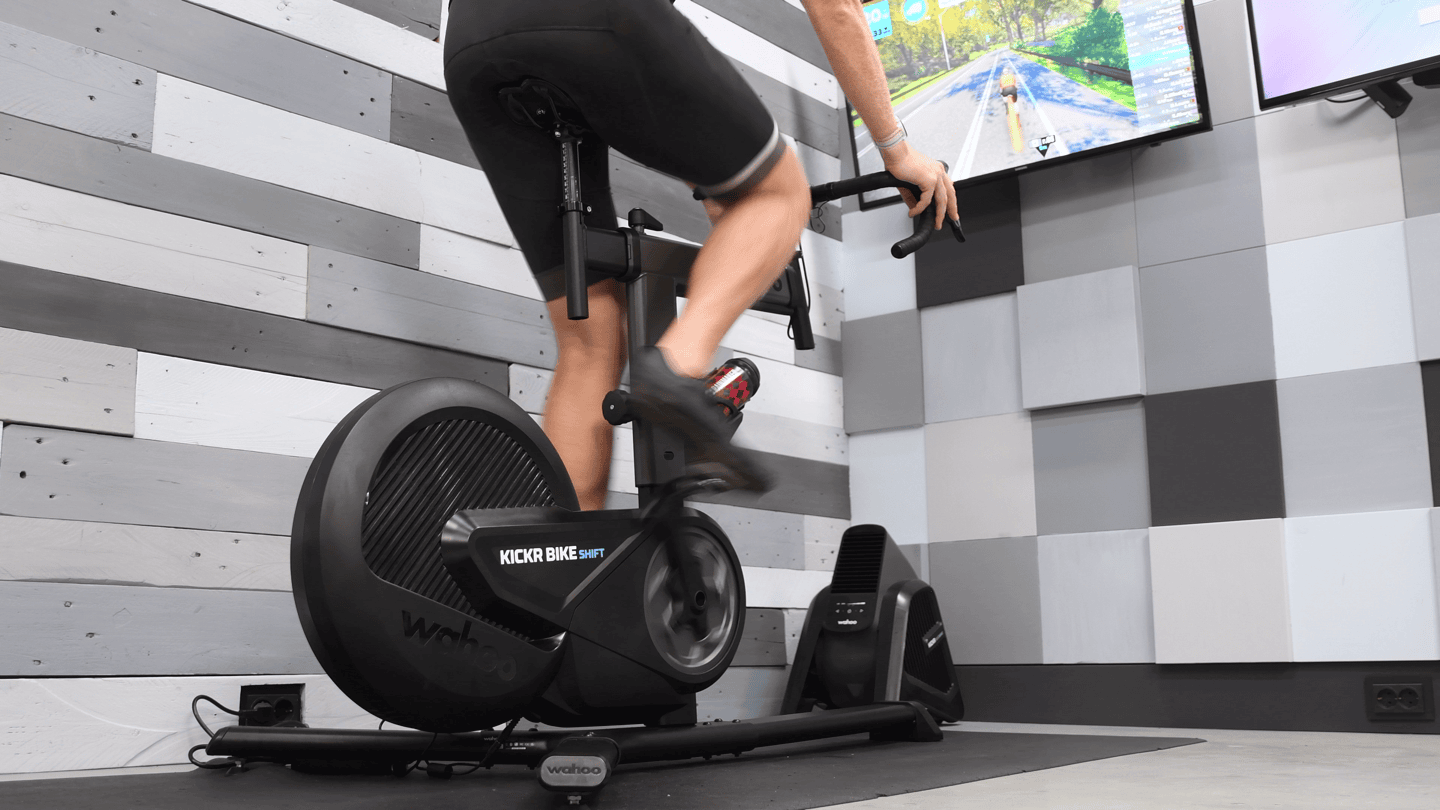
Likewise, on stability, as a tall dude, sometimes I see indoor bike/trainer designs that lend themselves more easily to tipping over. This isn’t one of those. I haven’t had any tipping/stability issues here. If you somehow manage to tip-over the KICKR Bike SHIFT, then you were likely doing some 50 Shades stuff with it. It’s not going anywhere with normal riding.
App Compatibility:
The Wahoo KICKR BIKE SHIFT follows pretty much all the same norms in terms of interoperability as other smart bikes, as well as virtually all smart trainers. As you probably know, apps like Zwift, TrainerRoad, Indievelo, Rouvy, FulGaz, Kinomap and many more all support most of these industry standards, making it easy to use whatever app you’d like. If trainers or apps don’t support these standards, then it makes it far more difficult for you as the end user.
To be specific, the KICKR BIKE SHIFT supports the following protocol transmission standards:
ANT+ FE-C Trainer Control: This is for controlling the KICKR BIKE SHIFT via ANT+ from apps and head units. Read tons about it here.
ANT+ Power Meter Broadcast: This broadcasts the KICKR BIKE SHIFT as an ANT+ power meter. This is handy for connecting your watch/bike computer to the KICKR SHIFT to record the data, without trying to control the resistance components. It’s how I record all of the data for accuracy tests.
Bluetooth Smart FTMS: This is used for controlling the KICKR BIKE SHIFT via Bluetooth from apps, like Zwift and more.
Bluetooth Smart Power Meter Broadcast: This broadcasts the KICKR BIKE SHIFT as a Bluetooth power meter. This is primarily used for Bluetooth-only watches to access your power data, like an Apple Watch or Polar/Suunto watch.
WiFi Direct Connect: WiFi is built-in, and allows the KICKR BIKE SHIFT to directly connect to WiFI for both game connectivity (effectively channeling your power meter/cadence/control over WiFi), as well as checking for daily firmware updates.
Ethernet Direct Connect (with adapter): This lets you buy Wahoo’s ethernet adapter, which connects on the back of the bike, to then plug into the network for wired connectivity for power meter/cadence/control.
The Wahoo KICKR BIKE SHIFT includes cadence data for any of the connections, so that data is baked into the power meter and trainer control streams. When you go to pair an app to the KICKR Bike you’ll see the cadence channel shown as well:

It’s these same standards that also allow you to connect via head units too. For example the Wahoo bike computers as well as Garmin bike computers that ANT+ FE-C for trainer control (or Wahoo Bluetooth Smart trainer control), so you can re-ride outdoor rides straight from your bike head unit to your trainer. Though realistically, very few people do that, given how good most apps are these days.
For me, in my testing, I used Zwift, IndieVelo, and TrainerRoad as my three main apps during my testing period. For both Zwift & IndieVelo, I used it with both SIM (simulates the ups/downs of a route), and ERG (structured workout mode). With TrainerRoad, there’s only ERG mode. Here you can see it paired up in IndieVelo:
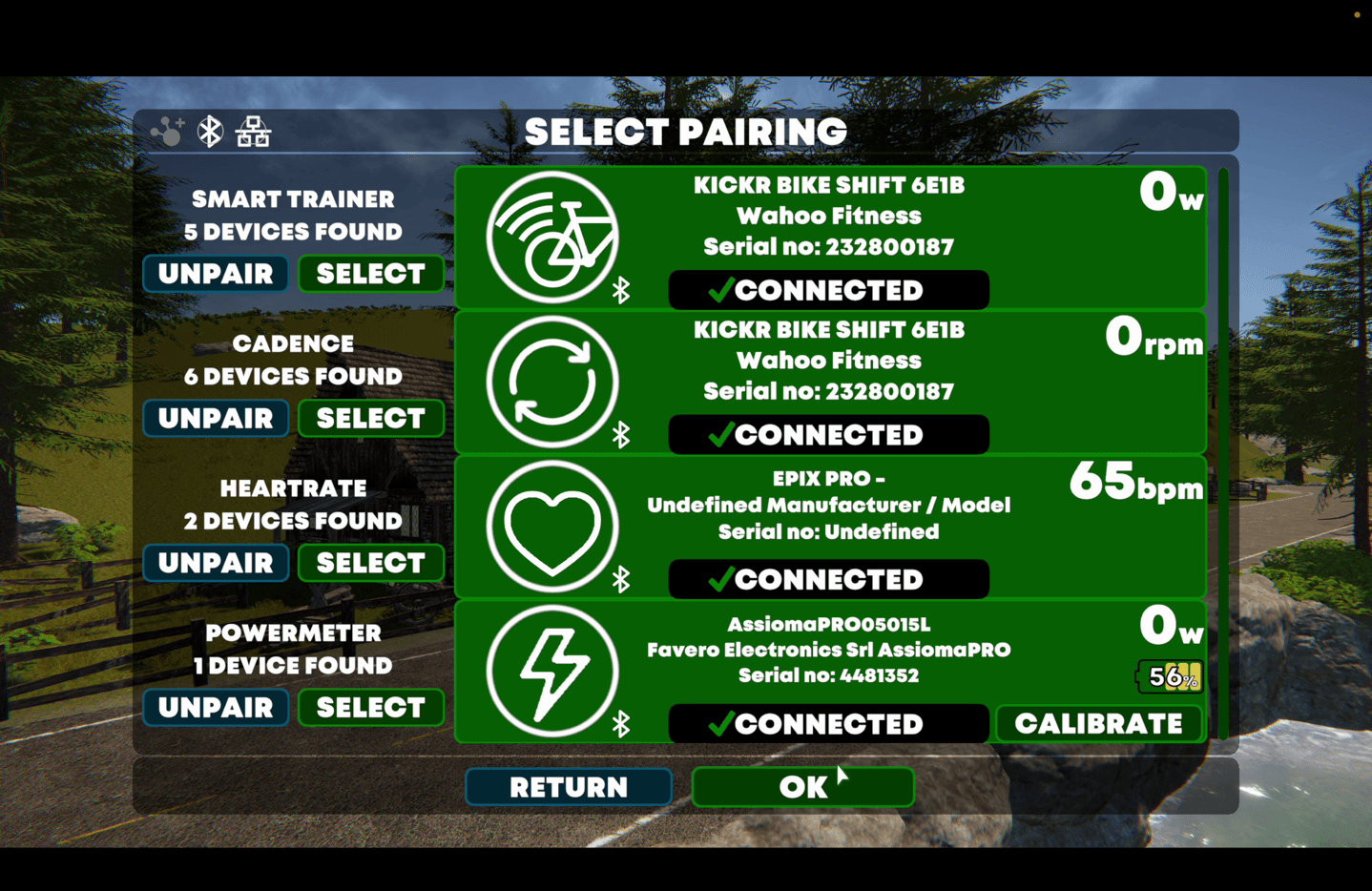
What’s cool here is that in IndieVelo, it does actually show shifting properly, whereas Zwift does not (as discussed earlier). Both shift just fine, but only IndieVelo is showing your current gearing.
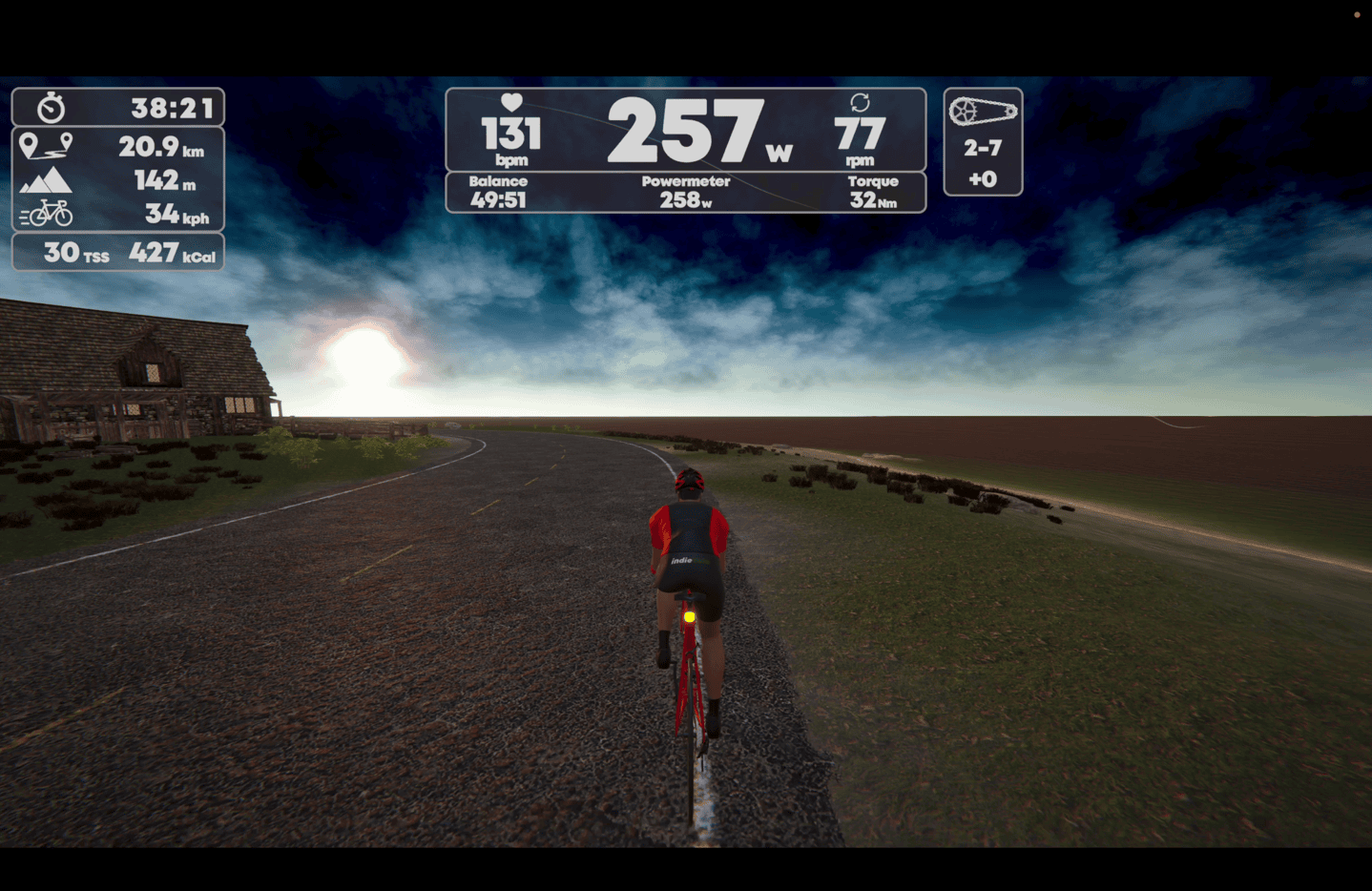
Meanwhile, in Zwift, everything works fine – including shifting and steering, but you just don’t yet get the gear display you would in IndieVelo. Of course in ERG mode, like below, gear display isn’t necessary:

I had no problems in either app from a compatibility standpoint in SIM mode, and likewise, also had no problems with TrainerRoad in ERG mode, which you can see here:

Now, not is worth nothing that from time to time I also used the Zwift Play buttons, which worked perfectly fine for me, attached to the KICKR BIKE SHIFT. For those not familiar, these allow you quick access to various Zwift functions. I suppose in an ideal world, Zwift and Wahoo would work together to either integrate this type of stuff, or allow better usage of Wahoo’s existing handlebar buttons for added controls.
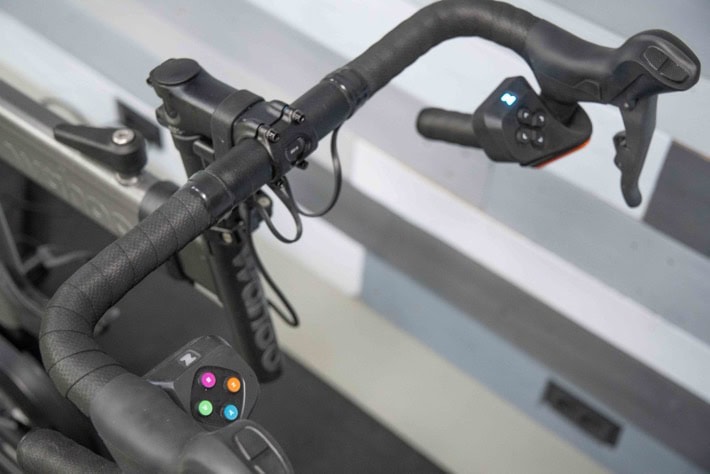
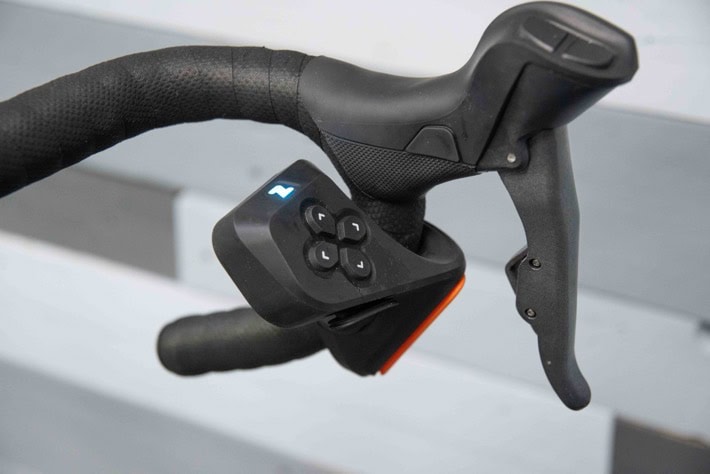
Still, if you’re looking to leverage the Zwift Play in your setup, this all works perfectly fine.
Power Accuracy:
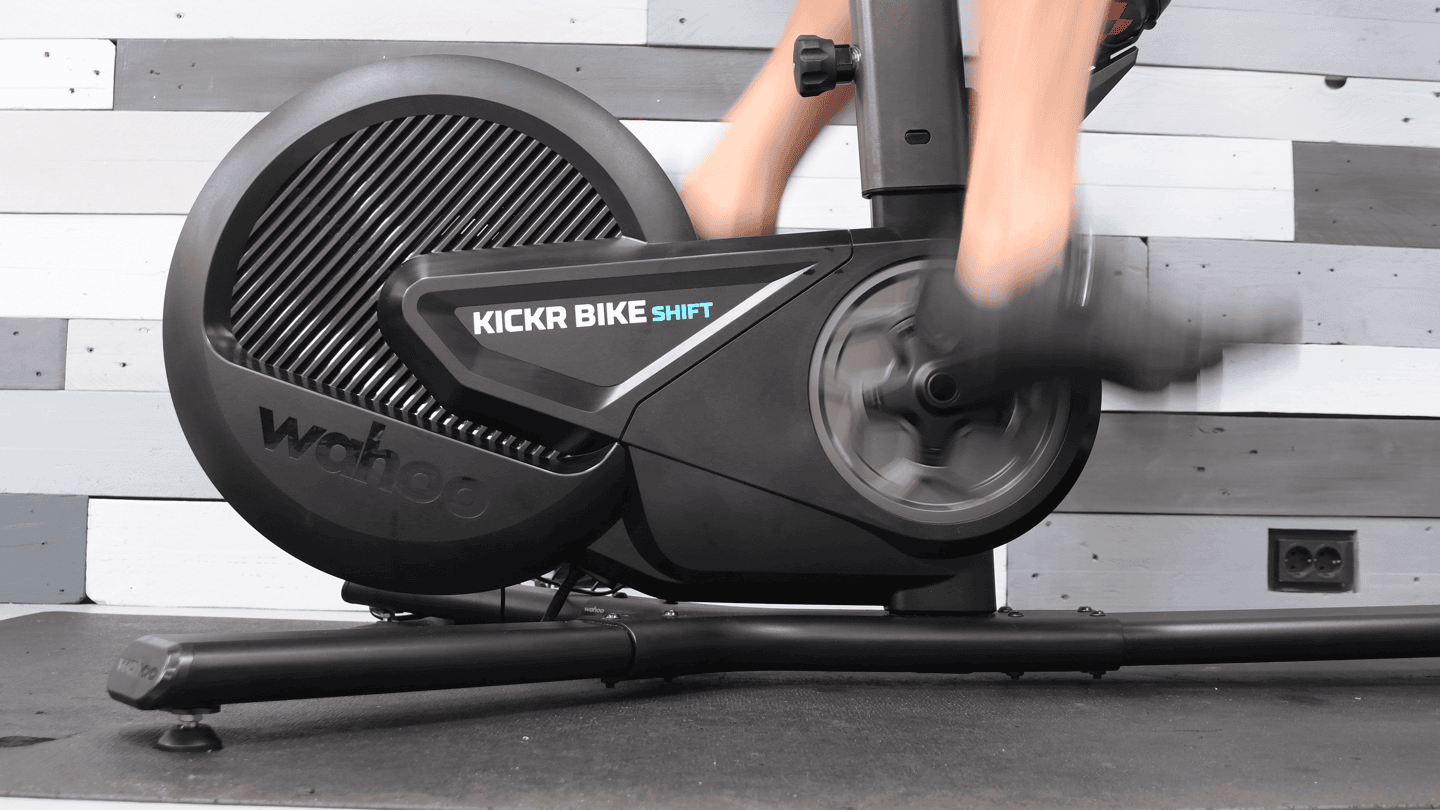
The whole reason this review is 9 months later is due to accuracy. Or rather, back at launch – inaccuracy. Initially it was due to a software bug that basically reset portions of the temperature compensation on my unit each time it updated the firmware (to a useless value). Thus I’d get one good ride, then one bad ride, and back and forth. Following that, for a month or so, it was just random bad-accuracy days. Eventually, I put it aside to deal with other products, and when I came back to it (a few firmware updates later), things were smooth sailing from then on out.
Thus, to spoil this section: It’s been good since mid-late November.
In any case, the goal here being that I’m comparing the KICKR BIKE SHIFT to a variety of known-good power meters, and testing everything from resistance control accuracy, to speed of change, to any other weird quirks along the way.
First up, let’s look at responsiveness. That isn’t directly accuracy, but we’ll get to that in a second. This piece looks at how fast the trainer responds to a given structured workout command (e.g. ‘350w’), and whether it’s within the acceptable range. Typically speaking, we want most trainers or smart bikes to get to a set point in about 2-4 seconds. We actually don’t want it to be 0 seconds, or even 1 seconds – as that’s like riding into a brick wall (such as going from 100w to 450w). Inversely, if it’s too long, it’ll cut into the benefit of certain types of intervals, such as micro-intervals.
For that, virtually every trainer/bike I test, I do a series of 30×30 tests. In this case, this test is on TrainerRoad, and we’re going to look at exactly how long it takes to reach the set-point and stabilize:

And that’s the other important piece: The wattage has to stabilize. We don’t want it to reach the 450w, and then blow through it and make you do 500w instead for the first 3-5 seconds. It needs to stick the landing.
Here we can see that it does stick that landing in 3 seconds each time. You’ll see some variability below, because I had done a longer trainer ride just before this one, so my legs were a tiny bit tired. Nonetheless, three seconds into each interval and it’s within 1w of the set point, and even the ‘above/below’ parts are only 10w out.

So then we look at the accuracy compared to other known-good power meters. In this case we’ve got a pair of Favero Assioma Duo’s (Shimano variant), to compare to, and you can see it’s within a few watts:

It’s a little bit easier to see, when I zoom in:

So, with that initial baseline established, let’s fast-forward to a longer ERG workout that I did last week, another slate of 30×30’s. In this case, you can see just how incredibly tight these are, compared to the Favero Assioma MX2 Pro pedals. Here’s that data set:
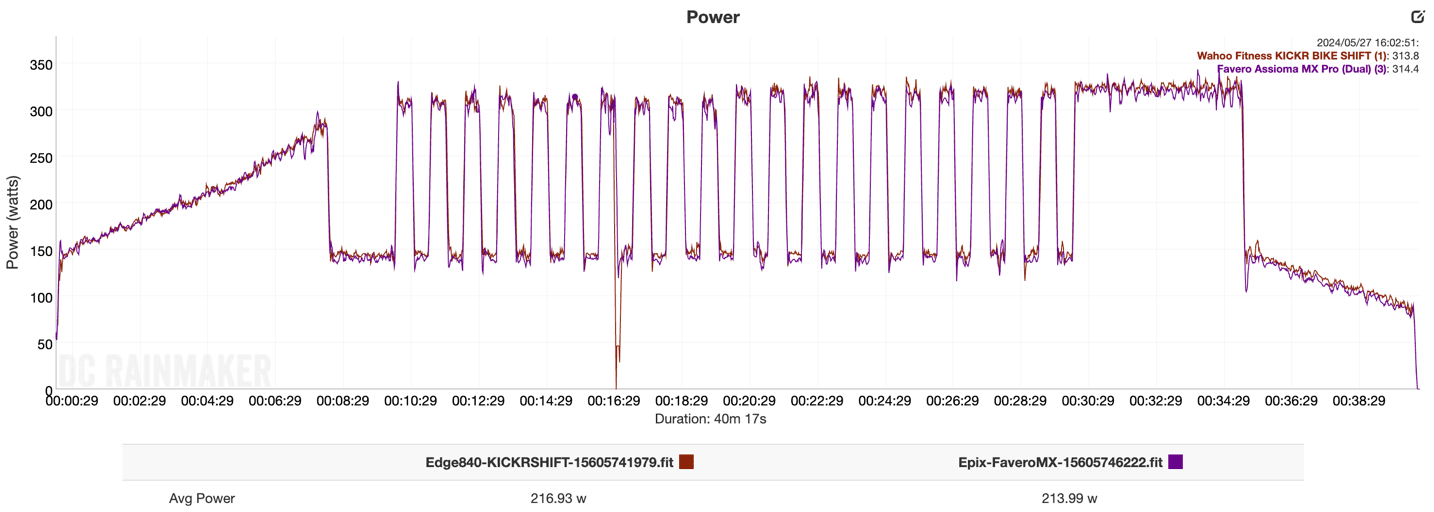
If you zoom in, you’ll see most of the time it’s within 1-3w:

Likewise, cadence is virtually identical. However, the scale here will throw you off (as well multi-second averaging on this graph):

Finally, check out the mean-max graph. Again, the scale here is really important to look at. These are an astonishing 3w difference across some of these chunks:

Ok, moving onto some SIM mode stuff, this time an Indievelo workout on rolling terrain. Here’s that data set:
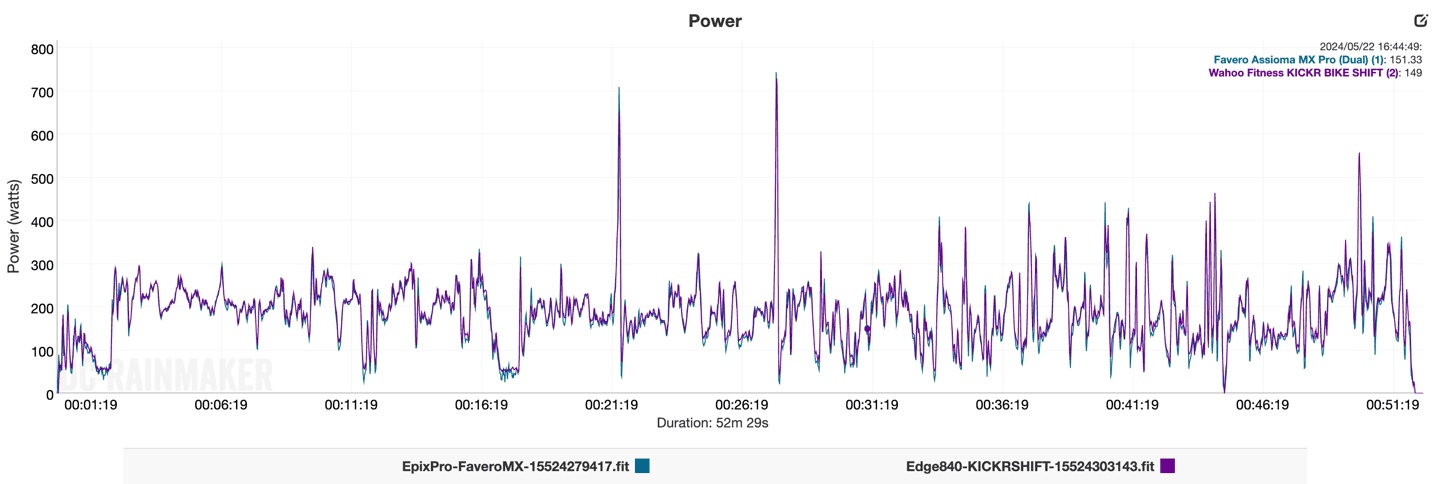
If we zoom into the sprints, we do see some slight differences at the absolute peak 1-second powers. In some cases, like this first screenshot, the Favero MX pedals are higher than the Wahoo SHIFT:

Yet in this case, on these surges, the SHIFT is higher than the Favero pedals:

In looking at many different scenarios, I haven’t seen a super-clear pattern as to why/when one is higher than the other.
In any case, cadence looks good:
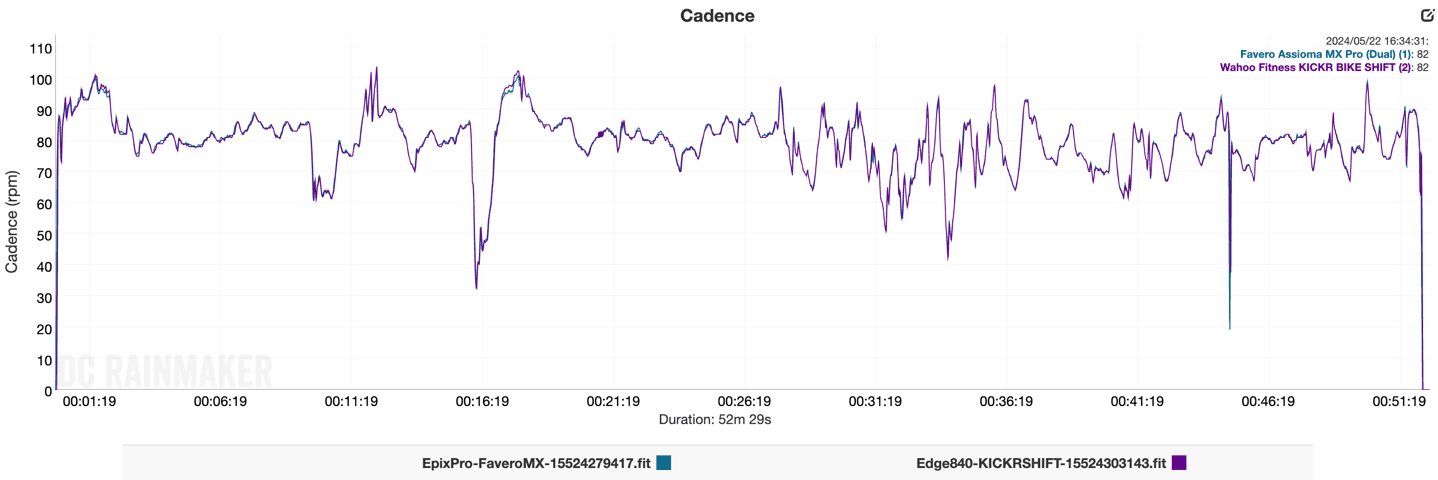
As does the again incredibly close mean-max graph:

Here’s another simulation mode workout, with some sprints towards the end:

These surges/sprints (shown with 3-second averaging), look very close, within a few watts – which is tricky to do at this power level, due to variations in transmission/recording timing:
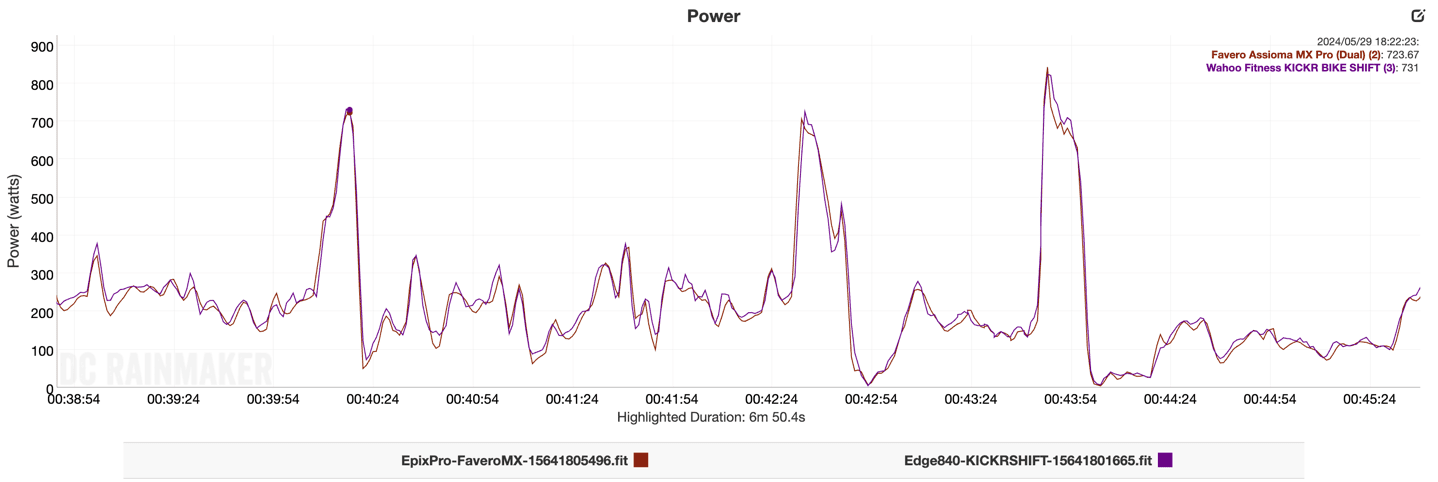
Likewise, cadence looks good too:
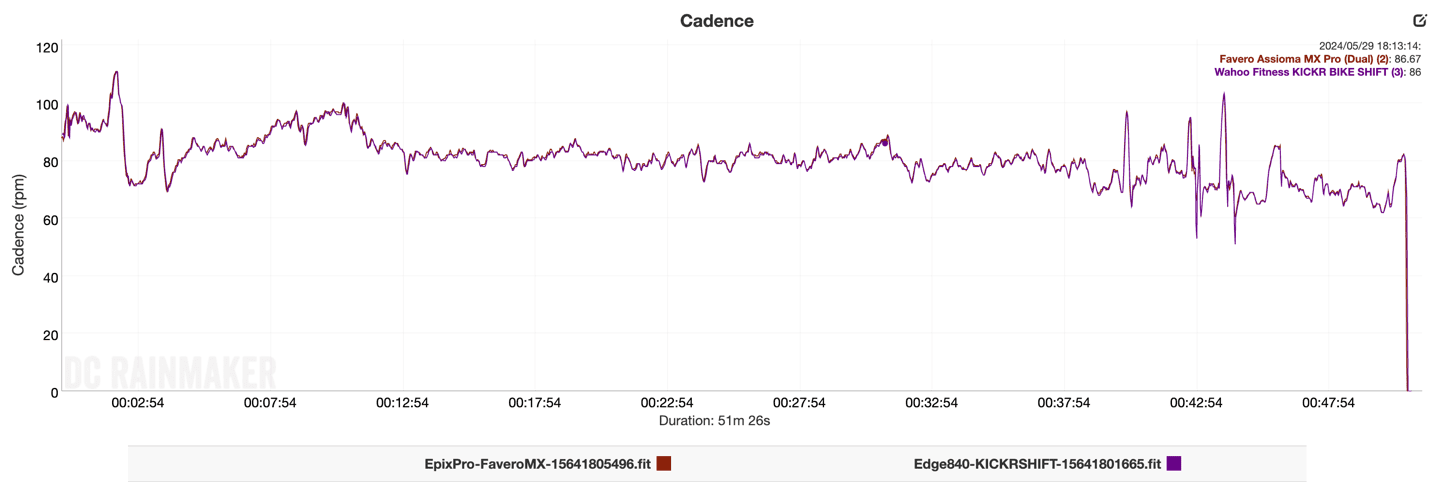
And again, so does Mean/Max:

Ultimately, while things started out (very rough) for my KICKR BIKE SHIFT last fall (as noted in my initial preview), with a few software updates, they’ve seemingly worked out any early teething kinks of the resistance unit.
At this point, in terms of responsiveness, accuracy, and stability, I don’t see any issues with the KICKR BIKE SHIFT, when compared to numerous known-good and trusted power meter pedals.
Indoor Bike Comparison:
Here’s the KICKR Bike SHIFT added to the product comparison database. In this case, I’ve put it up against the Wahoo KICKR Bike V2, the Tacx NEO Bike Plus, and Wattbike ATOM 2020. Of course, with Stages Cycling now out of business, I’d normally have added in the Stages SB20 in there somewhere. But…yeah. As a rule of thumb, I don’t put products in the product comparison database unless I’ve had hands-on/riding time with it. Thus, things like the newer Decathlon indoor bike isn’t in here yet.
| Function/Feature | Wahoo KICKR BIKE SHIFT | Wahoo KICKR Bike V2 | Tacx NEO Bike Plus | Wattbike ATOM 2020 |
|---|---|---|---|---|
| Copyright DC Rainmaker - Updated June 4th, 2024 @ 2:13 pm New Window Expand table for more results | ||||
| Price for trainer | $2,999 | $3,999 | $3,999 | $2,599 |
| Availability regions | Limited Initially | Limited Initially | Global | UK/South Africa/Australia/Scandinavia/USA |
| Power cord required | Yes | Yes | No | Yes |
| Flywheel weight | 13bs/5.9kgs | Simulated/Virtual 125KG | 9.28KG/20.4lbs | |
| Includes motor to drive speed (simulate downhill) | Yes | Yes | Yes | No |
| Maximum wattage capability | 2,200w @ 40KPH | 2,200w @ 40KPH | 2,200w @ 40KPH | 2,500w |
| Maximum simulated hill incline | 20% (and -15% downhill) | 20% (and -15% downhill) | 25% | 25% |
| Measures/Estimates Left/Right Power | No | No | Yes | Yes |
| Can directionally steer trainer (left/right) | Yes (with compatible apps) | Yes (with compatible apps) | YES (WITH COMPATIBLE APPS) | Planned late 2020 |
| Can simulate road patterns/shaking (i.e. cobblestones) | No | No | Yes | No |
Expect me to add more bikes to this list in the near future, including the Mouv bike that’s been at the DCR Cave for the last few months.
Wrap-Up:
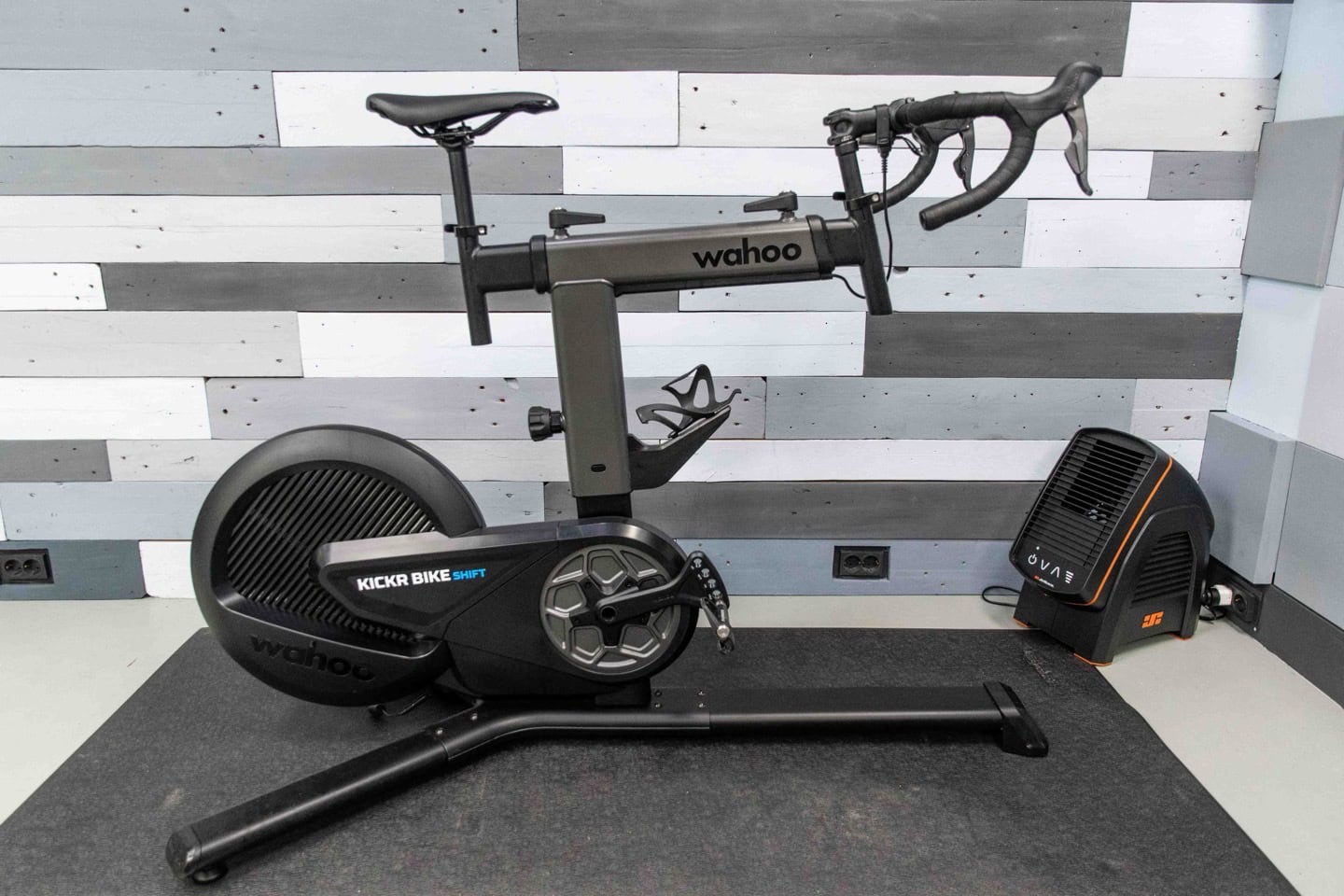
If you’re looking for an indoor bike, there’s plenty of options out there. Some great, some complete crap. And a bunch in the middle. The KICKR BIKE SHIFT is definitely in the great camp, just without the price tag of the higher-end full KICKR BIKE V2. While it lacks the physical up/down movement of the KICKR BIKE V2, it’s better in almost every other way. And as myself and many other KICKR BIKE owners have found over the last years, I rarely remember to unlock the up/down CLIMB portion of the KICKR Bike anyway. Thus, I’m not missing out on anything. Of course, it’s still a cool feature – but I personally wouldn’t pay that price difference at this point for just that feature. In the same way there will be a handful of people for which higher-speed data transmission of KICKR Race Mode will matter for.
Second, there’s just less things to break here. The KICKR BIKE V1 had plenty of physical hardware issues, as did most other V1 indoor smart bikes. Reality hit hard in this segment. The V2 bike has seemed to be much better on the hardware front, and by Wahoo’s own admission – most of the changes they made to V2 were aimed at reducing hardware issues. Likewise, most of the hardware changes made from KICKR BIKE V2 to to SHIFT were aimed at further eliminating hardware break points (e.g. anything that moved), as well as reducing the cost. The result seems quite solid.
Of course, with 9 months since the unit came out, I’ve been able to watch “The Internet” and their experiences with the SHIFT as well. On the whole, SHIFT buyers seem happy, but certainly there’s been a few people commenting with hardware-related failures. As always, it’s hard to figure out just how widespread it is, though, given how few comments relative to shipments there are, I think it’s definitely much better than the other Wahoo bike generations. However, I would agree with those that question why a $3,000 Wahoo smart bike (SHIFT) doesn’t have the KICKR Race Mode, yet a $1,200 Wahoo trainer does.
Nonetheless, If I was in the market for an indoor smart bike, the Wahoo KICKR BIKE SHIFT would definitely be in the running. But of course, there’s a lot of new entrants over the past year to consider. I’m sure at some point it’ll be time for a comparison post. With that – thanks for reading!
Found This Post Useful? Support The Site!
Hopefully you found this review useful. At the end of the day, I’m an athlete just like you looking for the most detail possible on a new purchase – so my review is written from the standpoint of how I used the device. The reviews generally take a lot of hours to put together, so it’s a fair bit of work (and labor of love). As you probably noticed by looking below, I also take time to answer all the questions posted in the comments – and there’s quite a bit of detail in there as well.
If you're shopping for the Wahoo KICKR BIKE SHIFT or any other accessory items, please consider using the affiliate links below! As an Amazon Associate I earn from qualifying purchases. It doesn’t cost you anything extra, but your purchases help support this website a lot. Even more, if you shop with TPC (The Pro's Closet), you'll save $40 on purchases over $200 with coupon code DCRAIN40! The Pro's Closet has been a long-time partner of the site here - including sponsoring videos like my cargo bike race, as well as just being an awesome Colorado-based company full of good humans. Check them out with the links below and the DCRAIN40 coupon!
Here's a few other variants or sibling products that are worth considering:
And finally, here’s a handy list of smart bike accessories that most folks getting a smart bike for the first time might not have already:
And of course – you can always sign-up to be a DCR Supporter! That gets you an ad-free DCR, access to the DCR Quarantine Corner video series packed with behind the scenes tidbits...and it also makes you awesome. And being awesome is what it’s all about!
Thanks for reading! And as always, feel free to post comments or questions in the comments section below, I’ll be happy to try and answer them as quickly as possible. And lastly, if you felt this review was useful – I always appreciate feedback in the comments below. Thanks!
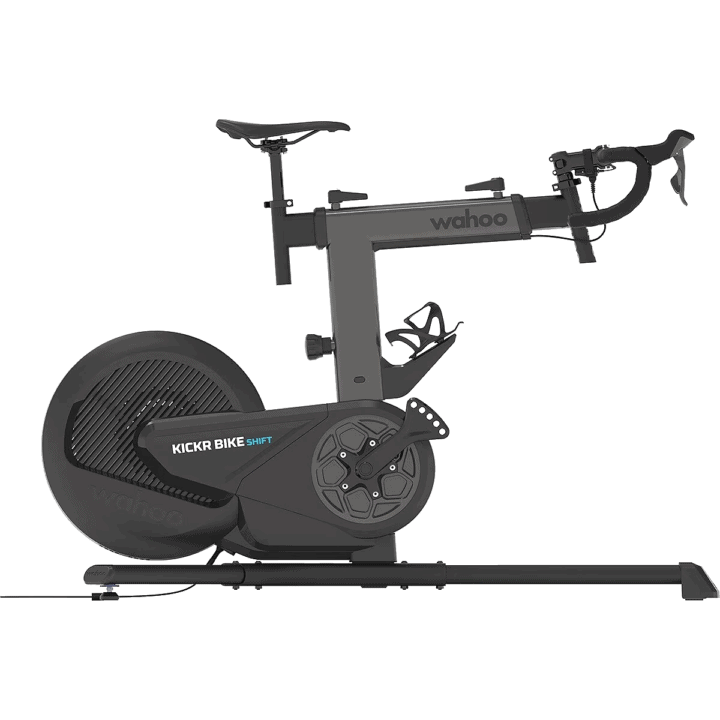








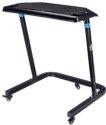



0 Commentaires